
Subscription Offers
Give a Gift


The Maiden Voyage of the Queen Mary
Richard Cavendish describes the maiden voyage of the Queen Mary on May 27th, 1936.
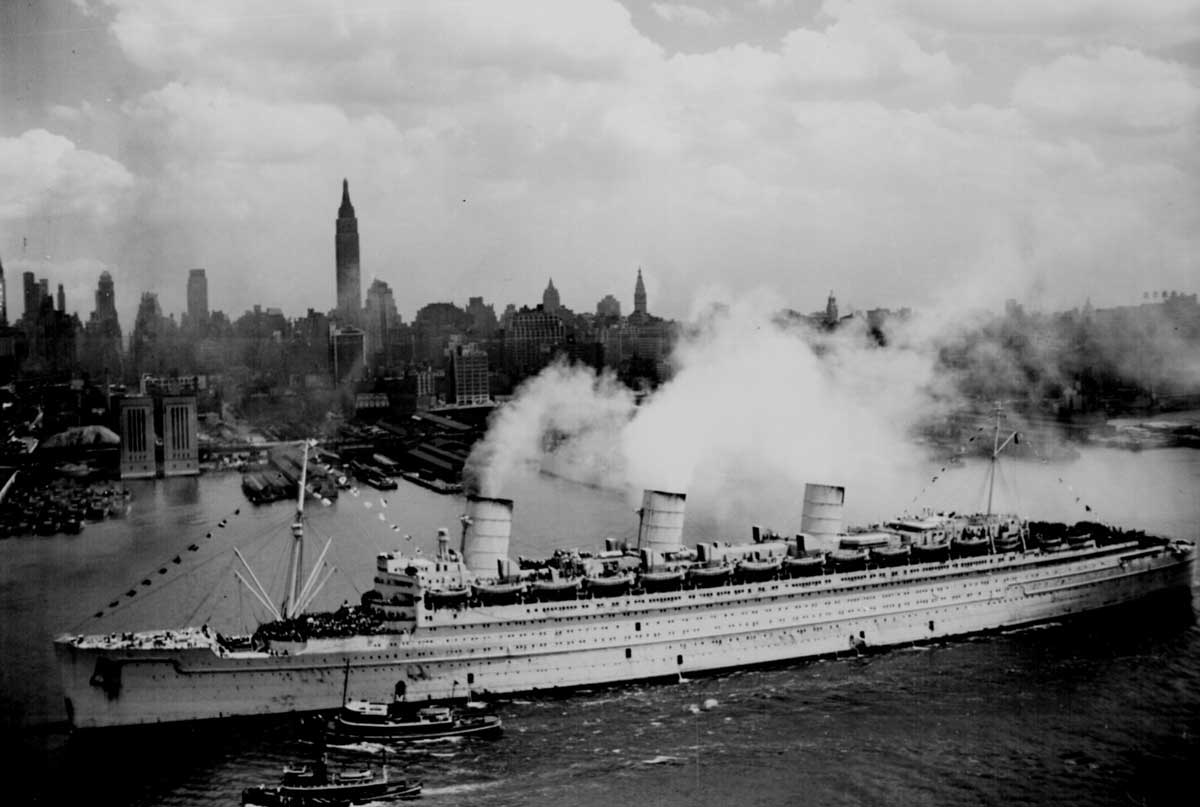
According to legend while the Cunard-White Star Line’s new Hull Number 534 was under construction at the John Brown and Company’s shipworks on the Clyde no women were allowed anywhere near it in case a feminine presence should distract a male worker from a delicate task at a critical moment. There were in fact many problems, but in the end the new vessel was formally launched with all proper ceremony in pouring rain on September 26th, 1934 by a woman: Queen Mary herself.
The 80,000-ton liner had been built in the teeth of the Great Depression to replace the ageing Mauretania and compete with British, German and French rivals on the Atlantic passage. Her keel was laid down in January 1931, but work had to be halted in December because Cunard had run out of money. The company turned to the government, which eventually produced a loan on condition that Cunard merged with its main British rival, the White Star Line, which was also in severe financial difficulty.
The Queen Mary boasted a top speed of more than 30 knots and a crew of 1,100, which was more than one for every two of her full complement of 2,100 passengers. With a stylish Art Deco interior, she had an indoor swimming pool, a library, a children’s nursery and a kennel for the passengers’ dogs. By May 1936 she was at last in Southampton ready for her maiden voyage to Cherbourg and then across the Atlantic. Supplies loaded included 50,000 lbs of fresh meat, 50,000 eggs, 14,500 bottles of wine and 25,000 packets of cigarettes.
Excited crowds watched the ship leave, a band played and an armada of vessels escorted her out of Southampton harbour. Fog prevented any hope of an Atlantic passage in record time and the ship was found to roll alarmingly and require far more handrails. At its worst, apparently, you could walk along a corridor with one foot on the wall.
The Queen Mary reached New York harbour on the morning of June 1st. Admiring crowds watched her make her way to her berth as bands played her in and many paid a dollar to charity to see round her. Cunard-White Star’s publicity department made much play of the approving comments from American publications: ‘A new peak in luxury at sea’ ( New York Times ); ‘Just about the most beautiful ship afloat’ ( The New Yorker ); ‘Regal a ship as ever ruled the waves’ ( New York American ). In August the Queen Mary took the coveted ‘blue riband’ of the Atlantic with a crossing in record time and the ensuing rivalry between her and the French Normandie would be constantly in the news for the rest of the decade.
Popular articles

Columbine 25 Years On

Challenging the ‘Ugliness’ of Anne of Cleves

- Hotel Rooms Choose from 200 original first class staterooms and suites Specials & Packages Packages & Special Offers Services & Amenities Modern amenities and world-class service Fitness Room Rejuvenate with our fitness options
- Attractions Tours & Exhibits Get an up close and personal look at the Queen Mary with our exciting tours & exhibits Summer Event Series Explore exciting activities and special events on The Queen Mary all summer long! Fourth of July Celebration Celebrate an all-American 4th of July aboard The Queen Mary! Queen Mary Heritage Foundation Membership Experience everything the Queen Mary has to offer with a tour package
- Dining Casual Dining Enjoy inspired meals and quick bites at our restaurants Chelsea Chowder House A contemporary restaurant offering memorable seafood dishes Bars Enjoy the 1930's classic sophistication of the Queen Mary bars Royal Sunday Brunch A local favorite, voted “Best Brunch” by OpenTable Group Dining Distinct dining options for groups of 15 or more
- Meetings & Weddings Meetings Explore one of the most unique meeting and conference venues in Southern California Weddings The Queen Mary has been host to unforgettable weddings for over 70 years Socials The Queen Mary is the ideal location for any social occasion Event Spaces Over 80,000 square feet of meeting and exhibit space across 14 Art Deco salons
- History Timeline Re-live the Queen Mary’s rich history, from her ground-breaking construction to today Stats & Fun Facts Everything you ever wanted to know about the Queen Mary Design & Preservation Learn about the era of elegant Art Deco design and how the Queen Mary is maintained with preservation projects Press Releases Press Releases about the Queen Mary Amateur Radio Discover the on-board radio stations starting in the 1960s
- Visit Hours & Parking Find open times for the Queen Mary and its dining and parking. On-Board Shopping An array of unique shops featuring souvenirs, one-of-a-kind treasures, clothing, memorabilia, historic documents, artwork and more Nearby Attractions The Queen Mary is a great central hub to all of Southern California’s most popular attractions Directions Your guide to getting to the Queen Mary
- What's On Deck
- Book Now Room Tour
Stats & Fun Facts
- Design & Preservation
Press Releases
- Amateur Radio
A Trip Across Time
"Today we come to the happy task of sending on her way the stateliest ship now in being. It has been the nation’s will that she should be completed, and today we can send her forth no longer a number on the books, but a ship with a name in the world, alive with beauty, energy and strength! May her life among great waters spread friendship among the nations!"
– King George V on the Queen Mary launch
The Queen Mary’s creation and launch was nothing if not extraordinary and her story is rich with history, elegance and grandeur. From the time her construction began in 1930 in Clydebank, Scotland, the Queen Mary was destined to stand in a class all her own. Despite suffering economic setbacks during the Great Depression, which stalled construction on the ship for several years, Cunard Line spared no expense on building the Queen Mary – which was originally known as job #534.
The Legend Behind The Name
Legend has it that the board of directors at Cunard had decided to name the ship the Queen Victoria, which would have been in keeping with the tradition of Cunard ships having the "ia" suffix (Mauretania, Aquitania and Berengeria). As per protocol, legend states that the Cunard directors went to ask King George his blessing of the ship's proposed name saying, "We have decided to name our new ship after England's greatest Queen," meaning Queen Victoria, the King's Grandmother. Upon which the King is reported to have stated, "My wife (Queen Mary) will be delighted that you are naming the ship after her."
The Maiden Voyage Of The Queen Mary
On May 27, 1936, the Queen Mary departed from Southampton, England embarking on her maiden voyage. She boasted five dining areas and lounges, two cocktail bars and swimming pools, a grand ballroom, a squash court and even a small hospital. The Queen Mary had set a new benchmark in transatlantic travel, which the rich and famous considered as the only civilized way to travel. She quickly seized the hearts and imaginations of the public on both sides of the Atlantic, representing the spirit of an era known for its elegance, class and style.
Since her retirement from the sea as an active liner in 1967, the Queen Mary has never been more popular as an iconic Southern California attraction, hotel, and venue for special events. The ship carried some 2.2 million passengers in peacetime and 810,000 military personnel in the Second World War, but here in Long Beach, an estimated 50 million people have visited. The day the ship was launched in 1934, a well-known English psychic, Lady Mable Fortiscue-Harrison would predict, “The Queen Mary will know her greatest fame and popularity when she never sails another mile or carries another fare-paying passenger.” A compelling insight!
A Timeless Treasure
Her majesty's mechanics, top of the queen, from the height of luxury to wwii.
For three years after her maiden voyage, the Queen Mary was the grandest ocean liner in the world carrying Hollywood celebrities like Bob Hope and Clark Gable, royalty like the Duke and Duchess of Windsor, and dignitaries like Winston Churchill. During this time she even set a new speed record, which she held for 14 years. But when the Queen Mary docked in New York in September 1939 that would be the last time she would carry civilian passengers for many years.
As World War II started, the Queen Mary's transformation into a troopship had begun. She was painted a camouflaged grey color and stripped of her luxurious amenities. Dubbed the "Grey Ghost" because of her stealth and stark color, the Queen Mary was the largest and fastest troopship to sail, capable of transporting as many as 16,000 troops at 30 knots. After the end of WWII, the Queen Mary began a 10-month retrofitting process, which would return the ship to her original glory. On July 21, 1947, the Queen Mary resumed regular passenger service across the Atlantic Ocean, and continued to do so for nearly two more decades.
The Last Great Cruise
The increasing popularity of air travel helped signal the end of an era for the Queen Mary. By 1965 the entire Cunard fleet was operating at a loss and they decided to retire and sell the legendary Queen Mary. On October 31, 1967, the Queen Mary departed on her final cruise, arriving in Long Beach, California, on December 9, 1967. She has called Southern California her home ever since. The Queen Mary is now a floating Hotel, Attraction and Event & Wedding Venue, home to three world-class restaurants and an icon in Southern California.
The Last Great Cruise Timeline Discover the Queen Mary's Incredible Journey Read More
Commodore everette hoard tells the tale of the last great cruise read more, learn the story of the last great cruise of rms queen mary.
Click here to view in a new window

Years of Glory
The Creative Years
1929 - 1935.
With a desire to replace Mauretania, Aquitania and Berengaria, the Cunard Line begins to discuss plans to build a new pair of super ocean liners. Undettered by lofty goals and the Great Depression, the building of the Queen Mary becomes a ground breaking technological achievement.
Glamour Years
1936 - 1939.
The Seeds Are Planted
At Cunard Line’s annual meeting, Chairman Sir Thomas Royden makes the first official announcement that “the question of new tonnage is one constantly in our minds.” The Cunard Line begins plans to design a new pair of super ocean liners to replace the Mauritania, Aquitania and Berengaria on their North Atlantic route.
Cunard Line announces that John Brown & Company, LTD., of Clydebank, Scotland, had been selected as builder of the new liner.
First keel plate is laid for job #534 (which was eventually named the Queen Mary) at John Brown Shipyard.
The Great Depression Hits
Work begins on the new Southampton dry dock, to be known as the King George V Graving Dock.
December 11
Work halts on Job #534 because of the Great Depression and an inability to secure further bank loans. The hull plating is 80% completed and the ship stands nine stories high.
The King George V Graving Dock is officially opened with King George V and Queen Mary steaming into the dry dock aboard the Royal Yacht, Victoria and Albert. The dock is the largest in the world at the time. It is 1,200 feet long, 135 feet wide at its entrance, 59 feet deep, holds 58 million gallons of water, and can hold any ship up to 100,000 tons.
The effective date for transferring the assets of the Cunard Steamship Company and the White Star Line, to the newly formed Cunard White Star, LTD. Cunard was credited with 62% of the share capital and White Star with 38%.
The North Atlantic Shipping Bill is passed. The British Treasury makes advances of £4,500,000 toward the completion of #534, and authority was to be sought to make an advance not to exceed £5,000,000 for a second liner.
After 28 months, construction resumes on job #534
Rivals Cunard Line and White Star are forced to merge.
September 26
Job #534 is launched, and named the Queen Mary by her Majesty Queen Mary, accompanied by His Majesty King George V. The ship is moved to the nearby fitting out basin.
September 28
Installation of boilers begins around this date.
Installation of engines and almost all of the heavy machinery is completed. Funnels and both masts are in position.
Unprecedented luxury and forward-thinking technology make the Queen Mary popular with British Royalty, Hollywood celebrities and dignitaries alike, raising the bar for luxury travel and ultimately becoming the grandest ocean liner ever built.
The War Years
1939 - 1946, the maiden voyage.
King Edward VIII makes inspection tour of the ship.
The Queen Mary departs John Brown Shipyard, steaming down the Clyde River to Gourock, Scotland. The ship goes aground twice despite prior dredging of the river and her shallow draft. Anchor trials and adjustment of the magnetic compasses are made off Gourock. Twenty of the Queen Mary’s lifeboats were left off the ship to save weight. Since they were manufactured in Gourock, the lifeboats were lifted into their davits upon ship's arrival.
March 24 - 26
Preliminary speed trials are made on the way to Southampton.
March 27 - April 8
Dry docked in King George V Graving Dock.
April 15 - 19
Official speed trials are held in the Irish Sea off the Isle of Arran. British Olympic runner Lord Burghley runs one lap (400 yards) in evening dress around the Promenade Deck in under 60 seconds.
The ship is officially handed over from John Brown Shipyard to Cunard White Star Line at exactly noon.
King Edward VIII, Her Majesty Queen Mary, the young Princess Elizabeth, the Duke and Duchess of York (soon to be King George VI and Queen Elizabeth), the Duke and Duchess of Kent and the Duchess of Gloucester visit the ship. Queen Mary presents her personal standard to the ship. It was displayed at the head of the main staircase on Promenade Deck and is now located on board the Queen Elizabeth 2.
The Queen Mary departs Southampton at 4:33 p.m. on her maiden voyage, arriving in Cherbourg, France at 8:47 p.m. and departing at 12:39 a.m. the following morning.
Arrival at Pier 90 in New York at 4:20 p.m. Crossing time: 5 days, 5 hours and 13 minutes.
August 19 - 31
On her sixth round-trip voyage, the Queen Mary wins the Blue Riband for the fastest North Atlantic crossings from the French Line's Normandie. The Normandie wins the honor back in 1937.
The World Record
Docked without the aid of tugboats in New York, by Commodore Irving. Voyage #53 West.
August 3 - 15
Won the Blue Riband back from the Normandie on her 48th round-trip voyage. The Queen Mary held the record
Departed Southampton on final peacetime voyage, carrying her largest number of passengers: 2,552, including Mr. & Mrs. Bob Hope and millions in gold bullion.
As England and France declare war on Germany, the Queen Mary’s days as a passenger ocean liner appear over. With her record-breaking speed and size, the Queen Mary is retrofitted to serve as a troop ship during WWII. Dubbed, the “Grey Ghost,” the Queen Mary hauled as many as 15,000 men while playing a pivotal role in guiding the allied forces to victory.
The Golden Years
1947 - 1961, september 2.
Crew members black out ship's portholes.
September 3
England and France declared war on Germany.
September 4
The Queen Mary arrives in New York.
The Birth of the Grey Ghost
Departs New York for Sydney, Australia, to be fitted as a troopship. Accommodations increased from 2,140 to 5,500.
First voyage as a troop transport. Sailed in convoy with Aquitania, Mauretania (II), Empress of Britain, Empress of Canada, and Empress of Japan, from Sydney, Australia, to Gourock, Scotland, with 5,500 troops.
August 5 - September 16
Dry docked in Singapore. Paravanes fitted.
December 13
Degaussing strip installed in Sydney.
January 27 - February 8
Hull damaged while entering dry dock in Boston Naval Shipyard. Troop capacity increased.
February 18 - March 28
"40 Days and 40 Nights" voyage from Boston to Sydney, Australia. First time the Queen Mary carried American troops (8,398 troops, 905 crew).
May 11 - 16
First time more than 10,000 persons had traveled on any ship (9,880 troops, 875 crew).
August 2 - 7
First time a complete division was carried on any ship. First Armored Infantry Division (15,125 troops, 863 crew).
The Queen Mary collides with British light cruiser Curacoa. Seventy tons of cement are used to temporarily patch the bow in Gourock, Scotland.
October 14 - November 2
Dry docked in Boston Naval Shipyard to install new more permanent bow piece.
December 23, 1942 - April 22, 1943
“The Long Voyage” from Gourock, to the Suez, Sydney, Australia, and return to Gourock. Total mileage: 37,943 miles. Ship transferred to Atlantic Ocean.
Winston Churchill transported from Gourock to New York, to meet with President Roosevelt. 5,000 German prisoners of war were also on board.
July 25 - 30
Carried the greatest number of people on a floating vessel: 15,740 troops, 943 crew. Total: 16,683.
August 5 - 9
Winston Churchill transported from Gourock to Halifax, Canada, for 2nd Quebec "Quadrant" conference.
August 27 - 31
Winston Churchil returns to Gourock, Scotland, with 15,116 troops.
D-Day Invasion of Europe.
The War Nears an End
Armament removed from ship, except the six-inch gun.
VE DAY (Victory Europe)
14,833 troops and 1,000 crew transported. total: 15,883.
Funnels repainted in Cunard colors.
February 3 - May 19
Six war-bride voyages, transporting 12,886 European brides and children to the United States and Canada.
May 23 - September 18
Seven war-bride voyages transporting European brides and children to Canada. Ten stowaways were discovered on the first crossing.
February 10
Docked in New York without the aid of tugs.
After a 10-month retrofit, the Queen Mary returns to her original glory. With her military duty over, the ship reclaims her place as a world-class ocean liner, but a sea of major changes is just starting to become evident.
Final Years at Sea
1962 - 1966, september 24 - 27, 1946.
The Queen Mary makes its final military voyage from Halifax to South Hampton.
February 15 - May 3, 1947
Work to restore the ship to passenger service begins as the ship at the King George Dry Dock.
May 3 - July 24
Furnishings reinstalled after being recovered from different ports around the world.
July 23 - 25
Participating in the post-war sea trials in the English Channel and met the Queen Elizabeth for the first time during peace off the coast of South Hampton in the Solant just off Cowes.
First post-war voyage departs South Hampton New York with 1,897 passengers, 1,280 crew members under the command of Commodore Illingworth.
Two ship service begins for Cunard with the Queen Mary and Queen Elizabeth
December 31, 1949
In 1947, Cunard shareholders acquired the 38% of Cunard-White Star that they didn't already own and in 1949 bought out the entire company, operating individually as the Cunard Line. The Cunard Line and White Star line merged in 1934 when the two companies had experienced financial difficulties.
June 15 - 20, 1951
Walt Disney sails aboard the Queen Mary to attend European Premier of Alice in Wonderland.
December 31, 1951
Winston Churchill and Foreign Secretary Anthony Eden sail aboard the Queen Mary to visit with President Harry S. Truman.
July 11 - 15, 1952
The SS United States secures Blue Riband traveling from Bishop Rock to Ambrose Light in 3 days, 12 hours and 12 minutes. The Queen Mary held the Blue Riband since August 8, 1938.
January 15 - 20, 1953
Winston Churchill sails to meet President elect Dwight D. Eisenhower.
November 1954
Queen Elizabeth returns to England aboard the Queen Mary after three-week good will tour of Canada and the United States.
January 26 - March 26, 1958
Stabilizers installed aboard the ship at King George Dry Dock in South Hampton.
April 22 - 23, 1958
Record turnaround in New York of 17 hours and 58 minutes. In the early days, the ship would be in port for 36 hours.
February 1961
Queen Mary transported 36 tons of gold and silver from South Hampton to New York.
The 1960s were a decade of major change and with the rise of popularity in air travel; ocean liners were slowly becoming obsolete. The old world luxury and sensibilities of the Queen Mary seemed outdated in a modern world now transfixed on the notion of space exploration.
Long Beach Years
1967 - present, march 3 - 9, the beginning of the end.
Wave floods parts of Main, A and B Decks. Voyage #382 East.
Docked without the aid of tugs in New York, by Captain Watts. Voyage #397 West.
Docked without tugs in New York, by Captain S.A. Jones. Voyage #419.
December 23 - 29
First cruise: Southampton to Las Palmas. Voyage #425.
February 25 - March 23
Mediterranean cruise: New York, Las Palmas, Tangier, Piraeus, Naples, Cannes, Palma, Gibraltar, Lisbon, Madeira, New York. Voyage #477.
Cunard announces that the Queen Mary is for sale.
First letter of inquiry from H.E. Ridings of Long Beach.
August 2 - 4
In King George V Graving Dock. Fastest ever turn - around in dry dock, and first time ever sailed with passengers from dry dock. Voyage #485 West.
August 24 - 29
Fastest eastbound crossing since Blue Riband record: 4 days, 10 hours, 6 minutes. Voyage #486 East. Second fastest Atlantic crossing since 1938.
Transatlantic Passengers:
1954 - by ship: 1,000,000; by air: 600,000 1957 - by ship: 1,000,000; by air: 1,000,000 1961 - by ship: 750,000; by air: 2,000,000 1965 - by ship: 650,000; by air: 4,000,000
Officially retiring from ocean travel, the Queen Mary was moved to sunny Long Beach, California where it is a living landmark, popular attraction and hotel, exposing a whole new generation of fans to bygone era.
Queens' captains open orders telling them of the decision to sell the Queen Mary and Queen Elizabeth.
First Meeting between Lord Mancroft and Long Beach, California representatives in New York.
$3.45 million Long Beach bid accepted.
September 22 - 27
Last Eastbound transatlantic crossings. Voyage #513 East.
September 29 - October 6
Cruise from Southampton to Las Palmas & Gibraltar. Voyage #514.
October 13 - 19
Cruise from Southampton to Las Palmas. Voyage #515.
Departed Southampton on Final Voyage to Long Beach, California. Voyage #516.
The Queen Mary arrives in Long Beach, California.
Removed from British registry and officially turned over to the City of Long Beach. Ship also became fully dependent on shore-side utilities.
April 6 - May 18
Dry docked at the Long Beach Naval Shipyard.
February 27
The Queen Mary moved to Pier J.
Queen Mary Story and Power Train Tour, and Upper Decks opened, weekends only.
Jacques Cousteau's "Living Sea" portion of Museum of the Sea (M.O.T.S.) opens.
February 20
Largest day’s attendance: 19,600.
First 150 hotel rooms opened.
Preview opening of Mary’s Gate Village (Now the Queen’s Marketplace).
Queen Mary Tour Inc. takes over operation of Museum of the Sea.
September 1
Wrather Port Properties Ltd., a subsidiary of Wrather Corporation, signs a 66-year lease to manage the Queen Mary and adjoining acreage.
Howards Hughes’ Spruce Goose flying boat opens to the public next to the Queen Mary.
Walt Disney Company buys Wrather Corporation for $152 million. The agreement includes the Disneyland Hotel, and management of the Queen Mary and Spruce Goose property.
City of Long Beach resumes responsibility for the Queen Mary from the Port of Long Beach.
Aero Club of Southern California announces sale of Spruce Goose to Evergreen International Aviation Inc. in McMinnville, Oregon.
Disney advises the City and Port of Long Beach that it will end its lease for the operation of the Queen Mary and Spruce Goose. The company agrees to operate the attraction until September 30, 1992.
September 30
Walt Disney Company gives up lease on the Queen Mary and Spruce Goose property. Remainder of 1992, The Port of Long Beach becomes operator of property, and looks for new operator. Hotel Queen Mary closes.
Spruce Goose is moved out of The Dome and put on barges headed to McMinnville, Oregon, having been sold to Evergreen International Aviation Inc.
December 31
The Queen Mary closes.
Joseph F. Prevratil, President & CEO of RMS Foundation, Inc. signs five-year lease with the city of Long Beach to act as operators of the Queen Mary.
February 26
The Queen Mary reopens to the public. Self-guided and guided "Captain's Tour" resume. Most restaurants and Sunday Brunch are back.
Hotel Queen Mary reopens with 125 rooms operational. Banquet rooms are operational.
Audio tours begin again in English, German, Japanese and Spanish.
Remainder of Hotel Queen Mary's 365 rooms reopen.
Captain John Treasure Jones, the 33rd and last captain of the Queen Mary dies at the age of 87 at his home in Chandler's Ford, England, just north of the port town of Southampton.
Diamond Jubilee Celebration of the 60th Anniversary of the Launch and Naming of the great liner. Officiating are RMS Foundation President Joseph F. Prevratil; H.R.H. Prince Michael of Kent representing the British Royal Family, grandson of Her Majesty Queen Mary; Scotland's Clydebank District Provost Jack McAllister and other special guests.
The Queen Mary celebrates the 25th Anniversary of its Opening Day
RMS Foundation, Inc., schedules Diamond Jubilee Celebration for the 60th Anniversary of the Queen Mary’s Maiden Voyage from Southampton to New York.
"Titanic: The Expedition" exhibit makes its West Coast debut aboard the Queen Mary.
The Queen Mary celebrates 30 years in Long Beach.
February 23
Two Cunard legends meet for the first time. The new Queen Mary 2 sailed into the port of Long Beach and greeted her historic namesake, the original Queen Mary. The two ships saluted each other with their one-ton signaling horns.
The Queen Mary’s amateur radio station (W6RO) is renamed the Nate Brightman Radio Room in honor of Mr. Brightman’s more than 40 years old dedication to the station.
The Queen Mary celebrates 40 years in Long Beach.
The Queen Mary celebrates her 75-year anniversary of the Maiden Voyage.
Diana: A Legacy of a Princess Royal Exhibit premiers at the Queen Mary.
Stats & Fun Facts
Discover the Queen Mary's incredible journey. Everything you ever wanted to know about the Queen Mary.
See how the Queen Mary measures up to Titanic. The results may surprise you! Read More
Discover hollywood celebrities and political dignitaries that are part of the queen mary's history. read more, preserving a historic icon.
On Sept. 26, 1934, at the John Brown & Company shipyard on the banks of the Clyde River in Scotland, Job Number 534, the largest ship the world had ever seen, slid down the launchways into the water as Queen Mary addressed the crowd, speaking into the microphone, "I am happy to name this ship the Queen Mary. I wish success to her and to all who sail her." One thousand and one transatlantic crossings later, the Queen Mary retired in Long Beach, arriving on Dec. 9, 1967. At exactly 12:07 p.m., John Treasure Jones, the Queen Mary's last sailing master, ordered "finished with the engines," signaling the end of one career and the beginning of another. The Queen Mary lives on now as a full-service Long Beach hotel, historical landmark and entertainment venue, giving visitors a unique glimpse into a bygone era when steamships were the most regal way to travel. The National Register of Historic Places Program is administered in California by the State Office of Historic Preservation, and placement on the National Register affords a property the honor of inclusion in the nation's official list of cultural resources worthy of preservation.
We thank all of our guests for their continued support of this truly wonderful ship. Check out the information below to find out how you can help support the Queen Mary and take a look at some of the recently completed projects. Email us at [email protected] if you have specific questions.
A Trip Back In Time
The Queen Mary has a long and distinguished history and we invite you to explore her past. We strive to locate and maintain as many authentic historical documents as we can in hopes of carrying on the Queen Mary legend. Please peruse and discover the rich history of the Queen Mary. If you have any authentic Queen Mary documents, lists or memorabilia that you would like to share with us, please email us at [email protected] or call us at 562-499-1791. Keeping the Queen Mary’s history alive and preserving her past is of utmost importance.
The Queen Mary Art Deco Style
The Queen Mary features some of the grandest, most intricate and beautiful interior designs ever aboard an ocean liner. Influenced by the Art Deco movement of the 1920s and 30s, the interior design includes strong curves and geometric forms representing elegance, glamour, function and modernity. Learn more about the ship’s iconic style here .
Check back for new and exciting updates about the Queen Mary
Royal Sunday Brunch | November 10, 2023
Reopening Announcement | March 24, 2023
The Queen Mary - Our Story – Amateur Radio
Radio during the queen mary’s decades at sea.
Like all other vessels of her era, the Queen Mary used maritime MF and HF radio frequencies to communicate with other ships and with shoreside high seas radio stations. Most of the world’s shipping lines contracted with radio companies to provide equipment and skilled radiomen for their ships, the largest being Marconi’s Wireless Telegraph Company. Cunard Lines selected the much smaller International Marine Radio Company to provide their ships with radio equipment and operators. IMRC designed and custom-built most of the equipment used on Cunard liners, and employed the radiomen who maintained and operated it. Some of that IMRC-built equipment is still on display in the Wireless Room. IMRC radiomen sailed on every voyage of the Queen Mary, using the radio callsign GBTT, providing communications in support of intership safety, navigation, weather, news reports, ship’s business, crew and passenger messages, and even radio-to-landline telephone calling for those who would pay the rather high prices for that service. Except for the ship-to-shore radiotelephone calls, most other traffic was passed using Morse code radiotelegraphy. In this era, radiotelegraphy was more efficient and reliable, being able to get through noise and signal fading much better than the AM and SSB voice modes. Even into the 1950s and 1960s when Amateur Radio became increasingly popular, IMRC radiomen weren’t much interested in tuning-in and operating on the ham radio frequencies. Indeed, after working a watch of four to six hours of pretty much constantly sending and copying Morse code traffic, the radiomen had little desire to do more of the same on the ham bands on their own time.
Amateur Radio Station GB5QM on the Queen Mary’s Last Great Cruise
Amateur radio first came aboard the Queen Mary for her Last Great Cruise in 1967. Upon learning that the City of Long Beach was considering the purchase of the Queen Mary to serve as a larger-than-life icon of its emerging status as an ‘International City’, Long Beach resident and radio amateur Nate Brightman, K6OSC, fell head-over-heels in love with the idea. He bent every ear and pulled every string he could to convince city leaders to go ahead with the deal. They heard him, and the purchase was made. Then, learning about the emerging plans for a Last Great Cruise to deliver the liner to Long Beach, Brightman hatched a plan to place an amateur radio station aboard the ship to contact and converse with radio amateurs around the world during the Queen Mary’s Last Great Cruise.
Brightman had to overcome many significant impediments to this project. The Cunard Line, US State Department, and the British Government all had to be brought into agreement to permit this event to happen. When all was arranged, Long Beach radio amateur Al Lee, W6KQI, led a team of amateurs as they flew to England, boarded the Queen Mary, installed their radio equipment, and broadcast from the Queen Mary at sea using the British-issued callsign GB5QM during the Last Great Cruise. Every radio amateur around the world who made contact with GB5QM was sent a commemorative ‘QSL’ (confirmation of radio contact) certificate. One of these certificates is still on display in the radio display room.
W6RO Aboard the Queen Mary in Long Beach
Nate Brightman’s vision for amateur radio aboard the Queen Mary did not end when she reached her final mooring in Long Beach. He was already at work on a plan to establish a permanent amateur radio station aboard the ship. This proved to be his most daunting undertaking ever, requiring 11 years of persistent negotiating to convince City and ship officials to grant his aspiration. Space was approved on the Sports deck in the structure originally housing the ship’s squash court. This was an ideal location as it provided direct access to the roof overhead for antennas and was in a position to be passed by visiting tourists as they exited the wheelhouse and officer’s quarters exhibits. Construction was funded by the City, and the console was re-created from Brightman’s own photos of the ship’s original Wireless Telecommunications console, formerly located on the Promenade deck portside, photos which he shot during a VIP tour shortly after the ship’s arrival in Long Beach in 1967.
Amateur radio equipment for the Queen Mary’s new Wireless Room was donated by the Swan Radio Company of Oceanside upon Brightman’s request to the company’s founder, Herb Johnson. The equipment and antennas were installed, some of the ship’s original radio equipment was added for display, and the new Wireless Room was opened for operation on April 22, 1979. Frm that date forward, volunteer radio amateurs from the local ham radio club, the Associated Radio Amateurs of Long Beach, as well as others from all over southern California, have staffed the Wireless Room, making radio contact with hams across the US and around the world and demonstrating ham radio to the ship’s tourists as they pass by. Many of them still use Morse code.
Brightman served as manager of the station from 1979 until his retirement in 2013 – nearly 35 years! The station was re-dedicated as ‘The Nate Brightman Wireless Room’ in 2007 in his honor. W6RO enjoys worldwide fame on the ham radio bands. Amateurs who make an on-air contact with the station are sent the very popular W6RO ‘QSL’ card commemorating their exchange with the Queen Mary.
Be sure to stop by the Wireless Room on your tour of the Queen Mary. And, if you’re lucky enough to encounter one of the volunteer radio amateurs there, enjoy a conversation about all things radio.
Tag your photos and share with the world
Socialize with us

The Maiden Voyage - 27 May, 1936
After completion, and brief trials to establish that her engines and other systems were functioning correctly, the Queen Mary arrived in Southampton for the start of her maiden voyage to New York.
- Fresh Meat: 50,000lbs
- Poultry: 20,000lbs
- Fresh Fish: 17,000lbs
- Bacon and Ham: 9,000lbs
- Sausages: 2,000lbs
- Vegetables: 50,000lbs
- Fruit: 30,000lbs
- Butter and Lard: 10,000lbs
- Eggs: 50,000
- Ice Cream: 6,000 quarts
- Wine: 14,500 bottles
- General Stores: 200,000lbs
- Potatoes: 50,000lbs
- Flour: 35,000lbs
- Beer: 20,000 bottles
- Keg Beer: 6,000 Gallons
- Cigars: 500
- Cigarettes: 25,000 packets
...and so, so much more. On this voyage, the ship also carried �2.5 million worth of gold bullion.
All was not perfect though. The main problems were to do with the ship herself. Firstly, the Queen Mary rolled from side to side a lot more than had been expected, and it was only now realised that there were no handrails for passengers to grab onto in the corridors. They had simply not been thought necessary: the models in wave tanks had not rolled. After a few voyages, workmen traveled on the ship to fit handrails to the corridors and to bolt down heavy furniture. The rolling problem was finally cured in 1956. One crewman (probably sober) reported a roll in a particularly bad storm (on a later voyage) of 44 degrees from vertical! That means you could walk with one foot on the wall and one on the floor.
Originally, no handrails were fitted in the corridors. Contrast this with today on the right
An engine problem arose at the beginning of the voyage. Some of the turbine blades had broken and come loose, and the damage was serious. The problem was the same in each of the four turbines. Nevertheless, the Queen Mary ran to New York before the matter was dealt with, but she attempted no records.
Another problem was a mysterious and very bad vibration at the stern of the vessel. The cure for this was to be expensive, with different propellers having to be designed, and strengthening posts needed between the decks. Some of the public rooms at the stern had to be rebuilt.
A flotilla of small craft met the Queen Mary in New York
In New York, the Queen Mary was met by a flotilla of small craft. After docking, she was again invaded by sightseers, this time paying a dollar each to charity. Everything that was not nailed down disappeared. One woman was arrested as she tried to take down a painting. The Queen Mary left to return to Southampton on Friday 5 June, 1936. The service had begun.
Return to History Index or go on with the history of the ship The War Years
Return to main index.
Please enter at least 3 characters
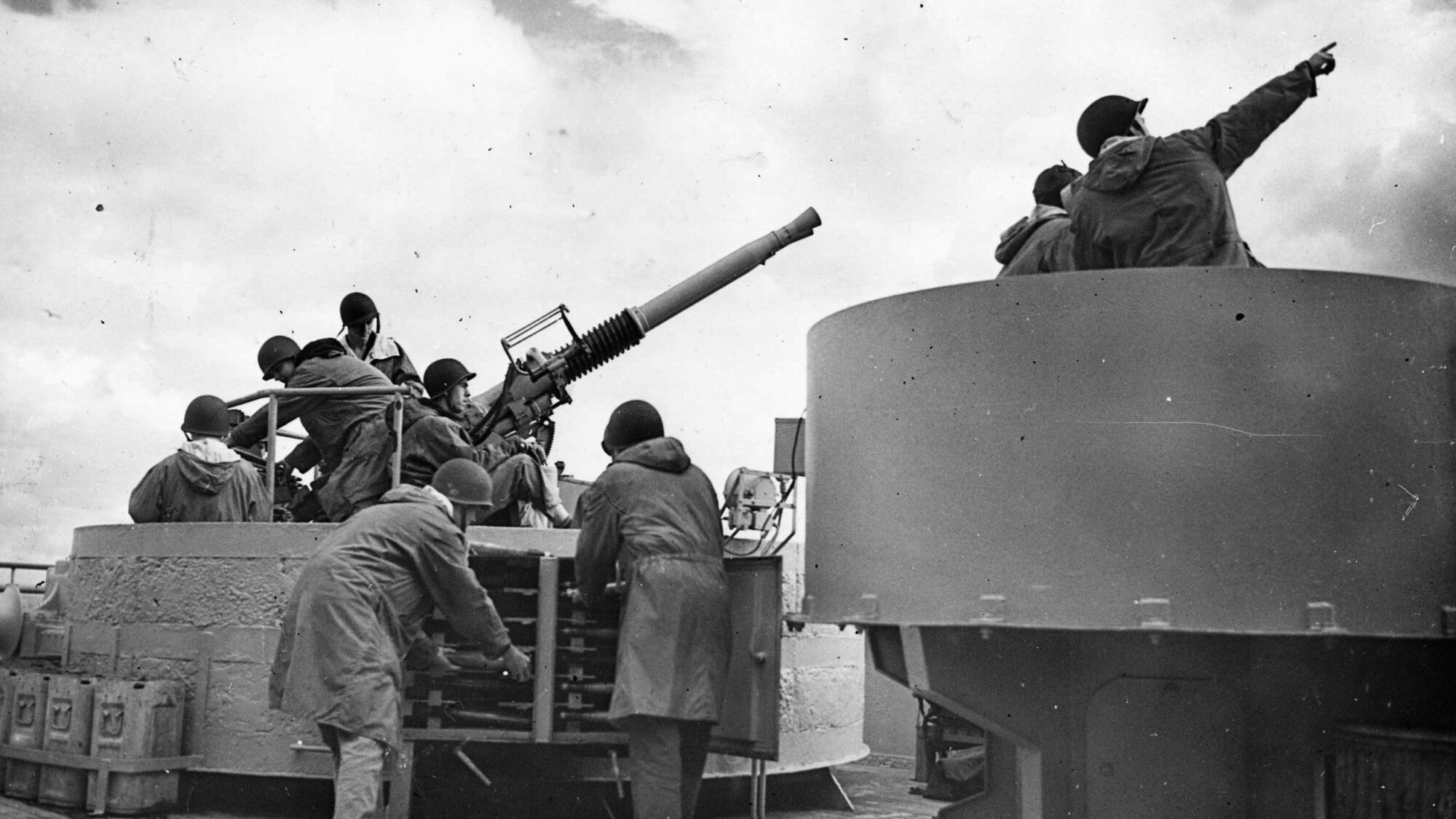
RMS Queen Mary’s War Service: Voyages to Victory
The war service of the RMS Queen Mary made a vital contribution to the success of the Allies.
This article appears in: March 2008
By Eric Niderost
The late summer of 1939 saw Great Britain teetering on the brink of war with Hitler’s Germany. The years of appeasement and vacillation, of meekly acquiescing to Hitler’s insatiable territorial demands, were over at last. Prime Minister Neville Chamberlain’s government pledged to come to Poland’s aid if it was attacked. It was clear that if the Polish crisis could not be settled amicably Europe would be at war within a matter of days. Southampton became a magnet for thousands of people seeking to escape the Continent before hostilities began. Many were Americans, who cut their holidays short for fear of being trapped on the wrong side of the Atlantic. One such “refugee” was entertainer Bob Hope and his wife, Dolores, who booked passage on the RMS Queen Mary . The Hopes were not alone, and in fact Queen Mary had a record 2,332 passengers aboard when she left Southampton on August 30, 1939.
The Queen Mary had survived the Great Depression, an economic hurricane that had once threatened her very existence. The great liner was designed to resist the fury of nature, but could the Queen Mary also weather the storms of war? Only time would tell.
Why the RMS Queen Mary Was an Instant Legend
RMS Queen Mary was Britain’s entry in the fierce transatlantic passenger trade. Commercial aviation was in its infancy in the 1920s and 1930s, leaving passenger liners the only viable way to get to Europe. Before World War I, most shipping companies made their money in steerage, transporting thousands of poor immigrants to new and hopefully better lives in America. But when Congress curtailed immigration in the early 1920s, steamship companies like Cunard faced serious financial difficulties.
The solution was to build one or two huge liners that would gradually replace older, smaller steamships on the transatlantic routes. It would be much more cost-effective. The spartan accommodations of steerage would be upgraded to a much more comfortable “third class” in order to attract middle-income passengers. The ships themselves would be the main attraction of the journey, or, as the old saying put it, “Getting there is half the fun.”
Cunard would build the first of its great new ships in the Clydeside region of Scotland. Clydeside is a stretch of the Clyde River that reaches west of Glasgow toward Gourock and the Western Approaches. John Brown and Co., Ltd., a shipbuilder of great experience and skill, was selected for the task, but the work was hardly put in hand before the Great Depression deepened and severely weakened the British economy. On December 11, 1931, all work was suspended indefinitely and 3,500 workers were laid off.
The British government stepped in, offering subsidies if Cunard merged with its great shipping rival, White Star. All parties agreed, and work resumed in April 1934, after a hiatus of a little over two years. Shipyard hull no. 534 became the Queen Mary , hailed as the largest and “stateliest” liner ever built. The ship was named after the wife of Britain’s reigning monarch, King George V. The royal couple was on hand when the ship was launched RMS Queen Mary was an instant success, a legend in its own time. Passengers were awed by its great size, measuring 1,019 feet long and displacing 80,677 tons. In peacetime, it was designed to carry 2,119 passengers and 1,035 crew. Queen Mary may have been large, but it was also incredibly fast. The ship could average around 29 knots, even faster if pushed a little.
The great steamship was the physical embodiment of Britain, an amalgam of British taste and 1930s refinement. The Art Deco style may have had its origins in France, but on Queen Mary it epitomized the British liner’s elegance and sophistication. Mahogany and other exotic woods, many from Britain’s own colonies, were used in the interior. In a very real sense Queen Mary was an expression of the island nation’s far-flung empire. The ship went into service in 1936, and in August of that year it captured the fabled “Blue Ribband” prize for the fastest transatlantic passage. Queen Mary had traveled from Southampton to New York in a record three days, 23 hours, and 57 minutes, averaging over 30 knots.
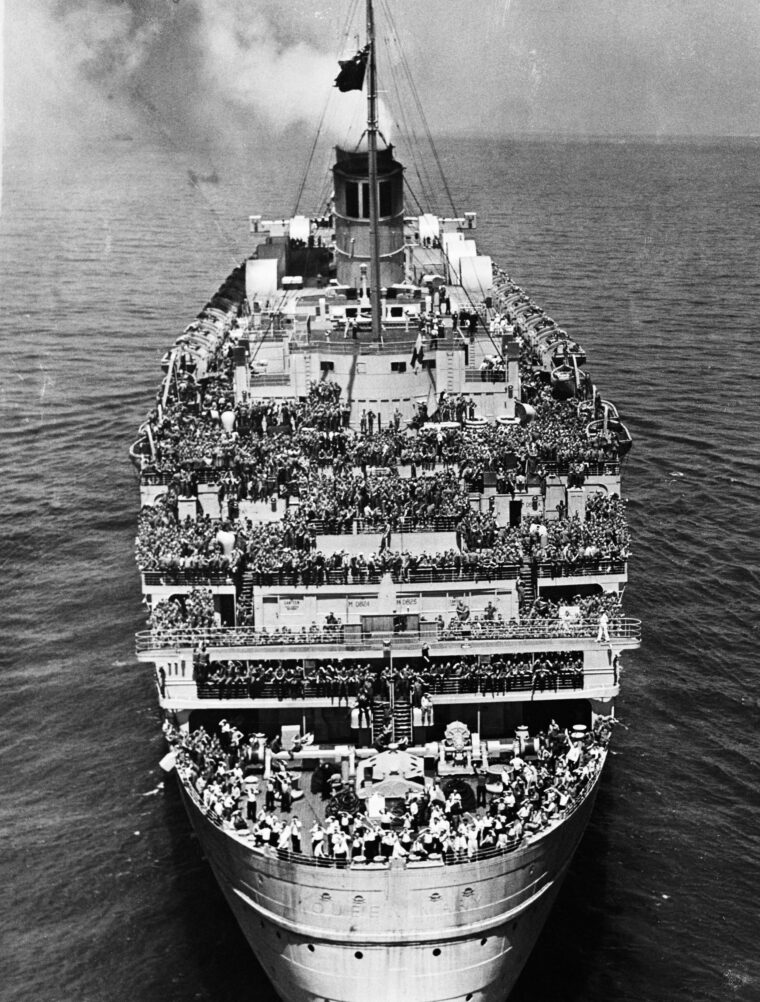
Queen Mary ’s growing fame attracted many celebrities of the period. Hollywood stars like Cary Grant could be seen in the Cabin (First) Class Dining Saloon, which featured a large intricately carved wooden map of the Atlantic Ocean, Europe, and America. Diners could follow the ship’s daily progress by observing a small crystal ship that was frequently repositioned on the map.
One Last Peacetime Voyage
The ship’s last peacetime voyage in August 1939 was anything but routine. Queen Mary ’s captain was ordered to sail about 100 miles south of her normal route as a precaution against lurking German submarines. On September 1, the German Army invaded Poland, and shortly before midnight on September 2, just a few hours after Britain’s ultimatum was delivered to Germany, Queen Mary received an urgent dispatch from the Admiralty. The ship was ordered to “take all necessary precautions” to guard against submarine attack.
The crew worked with a will, painting over portholes and rigging blackout curtains on doorways. Extra lookouts kept eyes peeled for periscopes or the telltale white streak of a torpedo wake. Tension grew, and the fear among passengers was palpable. The liner Athena had been torpedoed a short time earlier, which did nothing to lighten the mood. In an effort to calm nerves, the captain asked Bob Hope to do a show for his fellow travelers.
The comedian rose to the occasion, and soon had passengers roaring with laughter. Noting the crowded conditions, Hope did a parody of his signature tune, “Thanks for the Memory.” While his audience laughed, Hope sang, “Thanks for the memory, Some folks slept on the floor, Some in the corridor, But I was more exclusive, My room had “Gents” above the door.…”
Queen Mary arrived safely at Cunard’s Pier 90 in New York City on September 5, and was ordered to stay put for the foreseeable future. Most of the crew went back to Britain to serve in the war, leaving only a small maintenance crew aboard. The liner was well guarded against sabotage, even though the United States was neutral at the time. There was a fear—real or imagined—that German spies might try to damage the mighty vessel.
Converted For Wartime Use
In March 1940, the Queen Elizabeth joined her sister ship, Queen Mary , in New York. The newer ship was unfinished and less vulnerable in the United States. Both vessels would perform a vital service in carrying thousands of troops to far-flung battlefronts around the world.
The Queen Mary stayed in New York for the next seven months, idle and seemingly forgotten. But this neglect was more apparent than real. Back home in Britain a debate raged in the highest circles of government over what to do with the two Queens . Some suggested that they were “white elephants,” and one member of Parliament seriously suggested they be sold. Besides being vulnerable to attack—or so it seemed at the time—the Queen Mary and her sister ship would eat up tons of fuel oil that might be better used in warships.
Saner heads prevailed, and on March 1, 1940, Queen Mary was officially called up for the duration. As a first step, her prewar livery of white, black, and Cunard red was replaced by a drab coat of what the Royal Navy called “Light Sea Gray.” This camouflage, together with her great speed, would be Queen Mary ’s principal defense against marauding German U-boats.
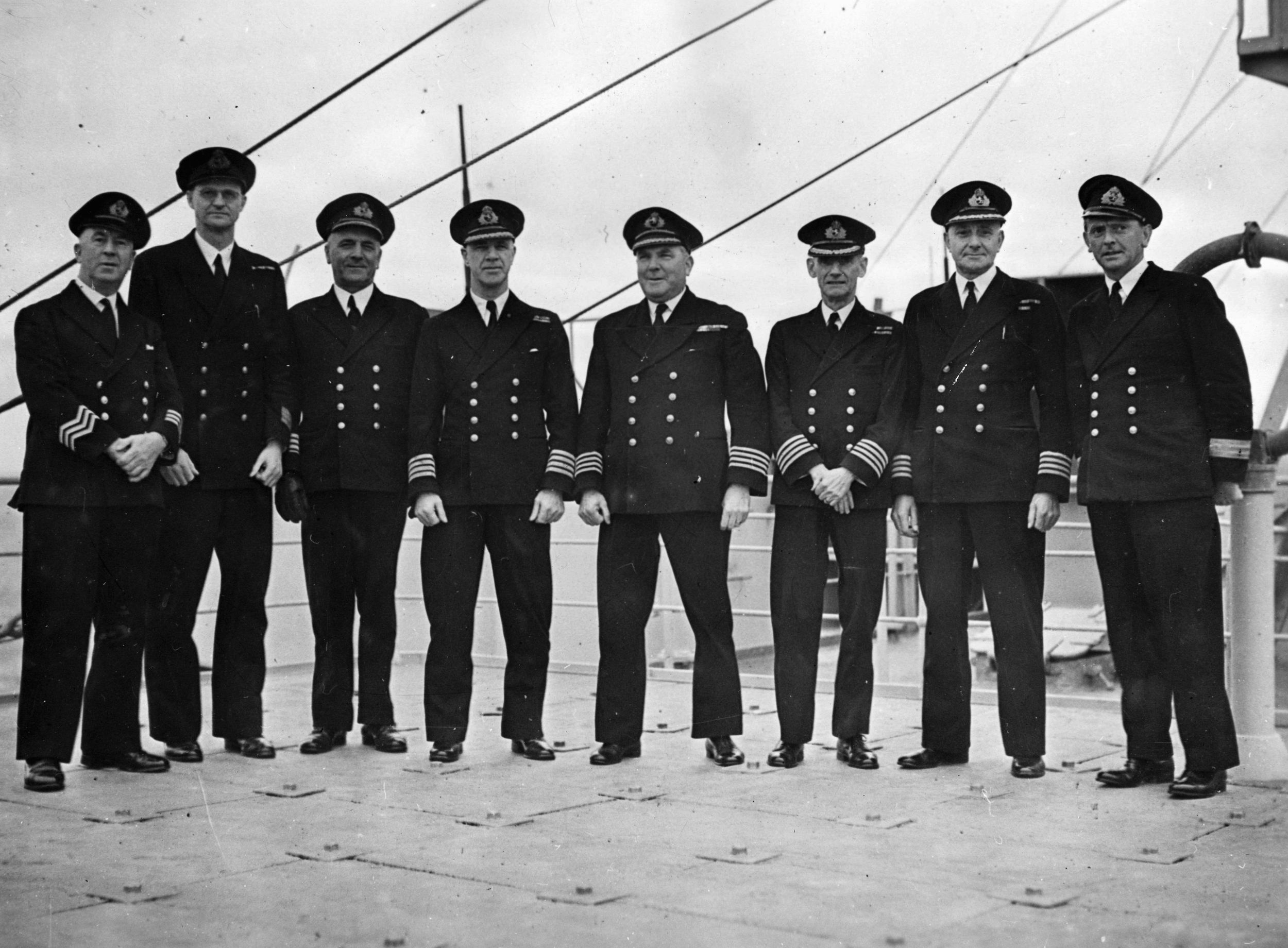
Queen Mary left New York on March 21, 1940, bound for Australia via the Cape of Good Hope. Once down under, the ship would undergo a major refit to turn her into a troopship. The liner reached Sydney on April 17, a voyage of some 14,000 miles made at an average speed of 27.2 knots. Once in Australia, Queen Mary was taken to the Cockatoo Docks and Engineering Co. pier to undergo its transformation. When the workmen were finished, Queen Mary could take 5,500 passengers.
The RMS Queen Mary ‘s Maiden Voyage as a Troopship
On May 4, 1940, Queen Mary left Sydney with 5,000 Aussie troops aboard. The great liner joined other “drafted” passenger ships similarly loaded with equipment and men, forming a huge convoy protected by the Royal Australian Navy. This first maiden troopship voyage was completed successfully, but the Queen’s arrival back in Britain coincided with the war’s darkest days. That spring, Hitler unleashed the blitzkrieg on Western Europe, overrunning Holland, Belgium, and ultimately France in a matter of weeks.
The British Expeditionary Force was pushed to the coast and barely escaped annihilation in the celebrated “ Miracle of Dunkirk .” The British Army had escaped destruction but was forced to leave all its vehicles and heavy weapons behind. The island nation, now truly alone, braced itself for a possible invasion. There was only one bright spot in this litany of gloom: Winston Churchill had replaced the inept Neville Chamberlain as prime minister. Churchill was a man who truly appreciated the importance of Queen Mary and her sister ship.
Defending Against Sea Mines
Queen Mary ’s primary mission would be to ferry troops to battlefronts where they were most needed, but she needed additional modifications. The ship was dispatched to Singapore, Britain’s great eastern bastion, where the transformations could take place. Japan, already embroiled in a major land war in China, soon occupied French Indochina. Tokyo’s ambitions knew no bounds, and its clear goal was nothing less than the control of East Asia.
The Japanese were careful to maintain peaceful relations with Britain and the United States, but war with the western powers was clearly on the horizon. In the meantime, the Queen Mary ’s focus was the worsening crisis in the Middle East. Italian dictator Benito Mussolini hoped to carve out a new Roman Empire in the Middle East by invading British-held Egypt, which was the site of the Suez Canal, Britain’s lifeline to India and the Far East, a jugular vein of communications that had to be held at all costs. Mussolini’s badly led forces were easily routed, but Hitler upped the ante by sending the German Afrika Korps to aid his ally.
Queen Mary arrived in Singapore on August 5, 1940, and slipped into a huge Admiralty drydock for the scheduled modifications. A degaussing coil was wrapped lengthwise around the liner’s exposed hull as protection against German magnetic mines. The coil consisted of five miles of copper wire that, when charged with electric current, effectively neutralized the ship’s magnetic field.
The Route From Sydney to Bombay
After the extensive refit, Sydney became Queen Mary ’s main base throughout 1941. In this period the liner shuttled troops from Australia to the Middle East, although she did not make the complete journey to the battlefronts. The ship usually stopped at Bombay, where the troops would transfer to smaller vessels that took them to Egypt.
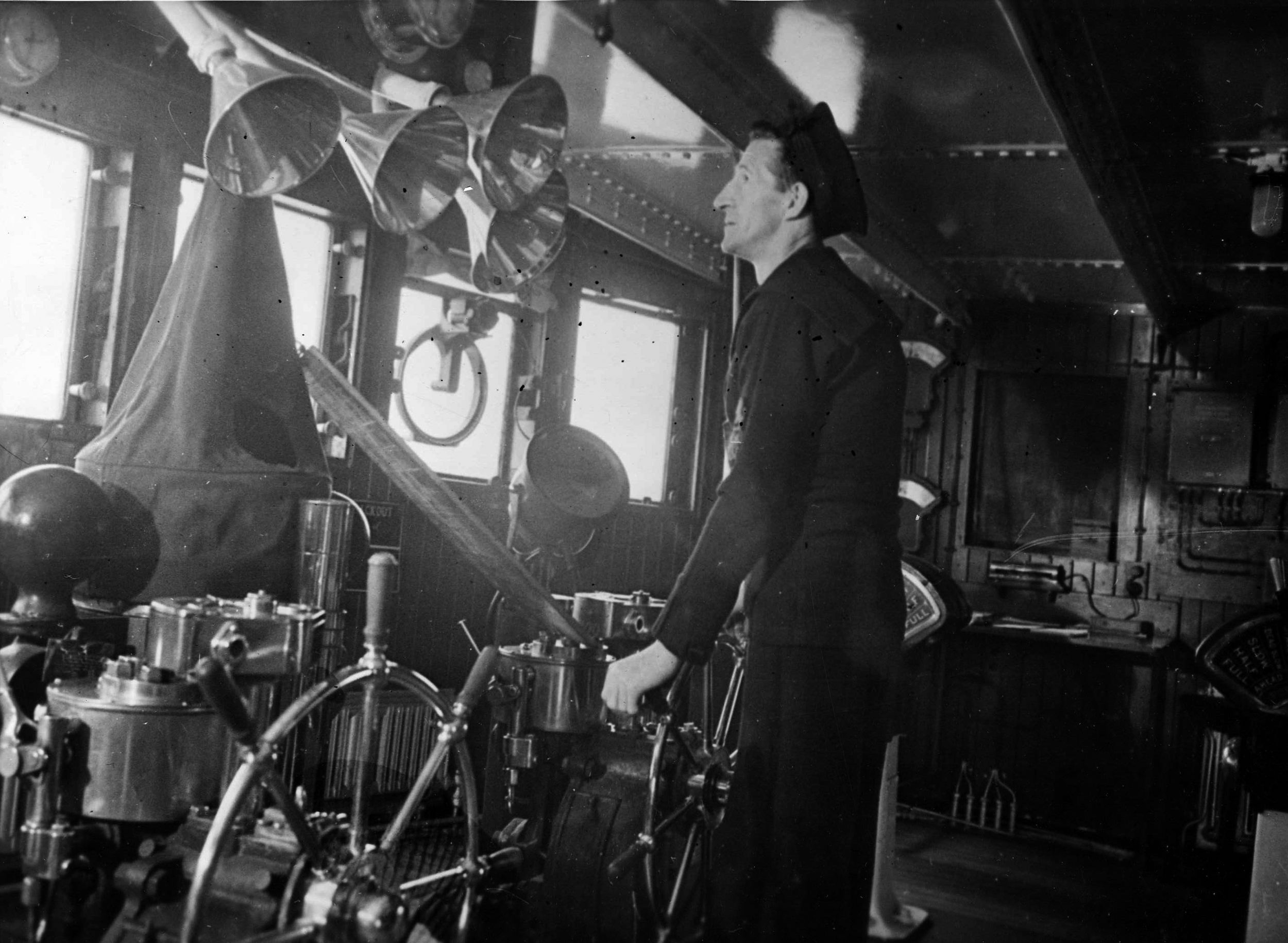
The open ocean is one thing, but the relatively narrow confines of the Red Sea exposed the ship to too much risk. If the liner was sunk, the psychological blow to morale—not to mention the loss of life—would have been devastating. On a strategic level, Britain would lose almost 20 percent of its troop-carrying capacity during the war. It was the kind of percentage that might tip the scales in Germany’s favor.
Australian troops were tough and hearty, with a sense of humor that delighted in poking fun at the pretensions of themselves and others. They needed this irreverent wit because tedious weeks aboard the Queen Mary could try the patience of a saint. The war with Japan was still months into the future, and the chance of encountering a “rogue” German U-boat was remote indeed. Unfortunately, the Queen Mary and Queen Elizabeth were designed for the cold North Atlantic, not the blistering heat of the tropics.
Torrid temperatures, not German torpedoes, became the chief threat in the summer months of 1941. Extra fans were jerry-rigged all around the ship, and saltwater showers were installed above decks. Awnings also were spread in an effort to deflect the sun’s burning rays. Unfortunately, these stopgap measures could not prevent temperatures rising well past the 100-degree range. Cases of heatstroke and heat exhaustion were multiplied, and on occasion there were one or two deaths from the oven-like temperatures.
The Queen Mary Under American Control
The December 7, 1941, Japanese attack on Pearl Harbor widened the war and brought the United States into the conflict on the Allied side. Churchill hurried across the Atlantic to confer with his new partners, although in truth the British and Americans had been cooperating with each other long before the formal declarations of war.
President Franklin D. Roosevelt and his advisers cordially welcomed Churchill that grim December, then set to work devising a strategy to deal with a two-front, two-ocean war. The Anglo-Americans agreed on a Germany-first policy, but where would the Queen Mary and Queen Elizabeth fit into the new realities of war? Their services as troopships were more needed than ever, but obviously the United States far outstripped Great Britain in terms of resources and manpower.
It was agreed that the Queens would be turned over to the Americans in a kind of reverse Lend-Lease, but that British Cunard crews would continue to run the ships under American operational control. But now that America was in the war, its troops were urgently needed, especially in the Far East. The Japanese were sweeping through Asia almost unchecked, and Australia was almost defenseless against Japanese aggression.
U.S. Army Chief of Staff General George C. Marshall met with Churchill to discuss how many people the Queens could carry effectively. Marshall had the idea of shipping at least 10,000 men, perhaps even 15,000, aboard one vessel. The figure is significant because a single division could number 15,000 troops.
Queen Mary ’s lifeboats could carry a maximum of about 3,000 souls. Add all available rafts and floats, and the number might boost to 8,000. The liner often was unescorted because her speed was considered her best defense. But if the Queen Mary was torpedoed, roughly half of her passengers might meet the same fate as those aboard the ill-fated Titanic —death by drowning or hypothermia.
Churchill was a complete romantic who loved pageantry, tradition, and the past. Churchill was also a hard-headed realist who did not shrink from difficult and even controversial decisions if the need arose. The prime minister’s reply to Marshall was unequivocal: “I can only tell you what WE would do. You must judge for yourselves the risks you will run. If it were the direct part of an actual operation, we should put all on board they could carry…. It is for you to decide.”
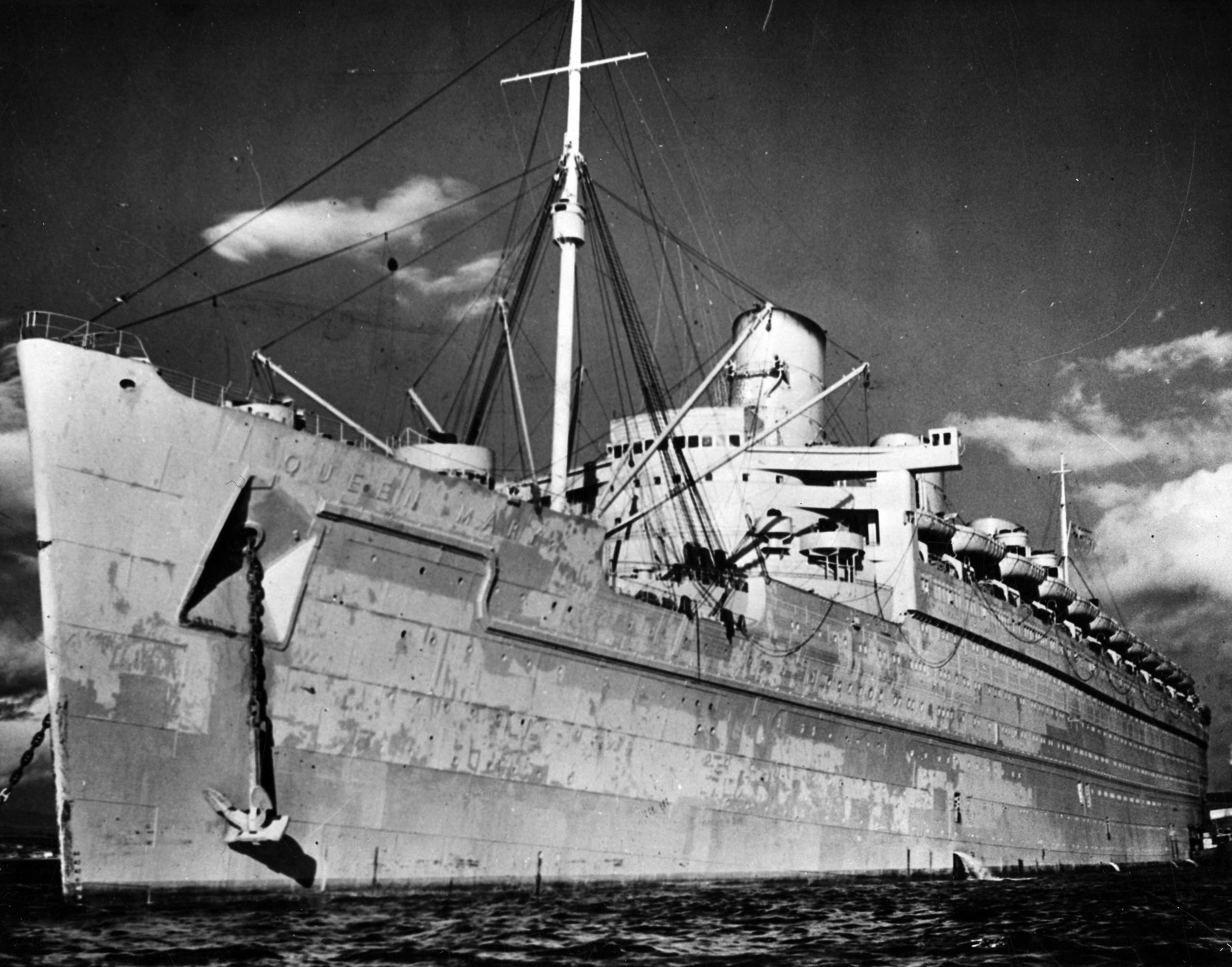
In the end, the Queen Mary would carry 15,000 passengers, but not right away. In January 1942, the ship was in Boston undergoing another refit that would boost her passenger load from 5,000 to 8,500. The ship needed to upgrade her defensive capabilities as well. Before 1942, she had been protected by a single 4-inch gun and a few scattered Vickers and Lewis machine guns.
Now, she was to have the armaments roughly equivalent to a light cruiser. The list included 40mm cannon in five double mounts sited fore and aft and 24 single-barrel cannon emplaced in steel tub mounts along the ship’s upper structure. Six 3-inch guns were also aboard, as well as two antiaircraft rocket launchers near the aft funnel.
U-Boats on the Hunt
When the job was complete, the Queen Mary embarked 8,398 American soldiers, most of them artillerymen or ordnance troops of one kind of another. Her destination was Sydney via Trinidad, Rio de Janeiro, Cape Town, and Freemantle. The liner left Boston on February 18, 1942, under bright blue skies that seemed to augur a safe passage. In fact, this trip was one of the most dangerous of the Queen Mary ’s entire wartime service. The period from January to August 1942 was fondly remembered by German submariners as “the happy time,” a period when they were winning the vital Battle of the Atlantic. In these eight months no less than 609 Allied ships went to the bottom, a staggering 3.1 million tons in all. The Queen Mary would have been the greatest prize of all. Adolf Hitler offered a million reichsmarks, about $250,000, and the Iron Cross with Oak Leaves to any submarine captain who could successfully torpedo the Queen Mary .
Increased U-boat activity around Trinidad forced a slight change in plans. The Queen Mary was diverted to Key West, and it was there that Captain James Bisset took command of the vessel. A 35-year veteran of the sea, he was nevertheless amazed by the Queen Mary ’s great size. “Gazing up at her,” he later recalled, “I felt overawed at the responsibility soon to be mine….”
Once on the bridge, Bisset had little time for such reflections. The Queen Mary sailed on the westward side of Cuba, then east into the Caribbean, finally breaking into the wide Atlantic via the Anegada Passage. Bisset had no idea that two German submarines, U-161 and U-129 , were not far behind following the same route.
The Queen Mary ’s radio operator picked up a distress signal from a torpedoed tanker only 10 miles astern of the giant liner. In fact, this same tanker had passed the Queen Mary only 45 minutes earlier. Captain Bisset ordered full speed ahead, and the liner safely reached Rio on March 6, 1942.
The Queen Mary was in even greater danger in Rio. Count Edmondo di Robilant headed an Italian spy ring in South America, and according to some versions of the story had actually obtained a copy of the ship’s sailing schedule. Robilant or one of his confederates secretly radioed German submarines with the intelligence that the great ship was anchored at Rio, but luckily the message was intercepted by Allied intelligence.
Captain Bisset was told to refuel quickly and leave port as soon as possible. Forewarned, the ship left Rio several hours before its scheduled departure. The Queen Mary escaped in the nick of time. An oil tanker that left port about the time of the liner’s original sailing was torpedoed a few miles out to sea. It looked as if a German submarine had been lurking in ambush.
The Germans refused to believe that the Queen Mary had slipped the net; in fact they proudly announced the sinking of the great ship. Hearing this, Captain Bisset remarked to his communications officer, “Keep this news under your hat. Don’t let the troops know we’ve been sunk. It might worry them!”
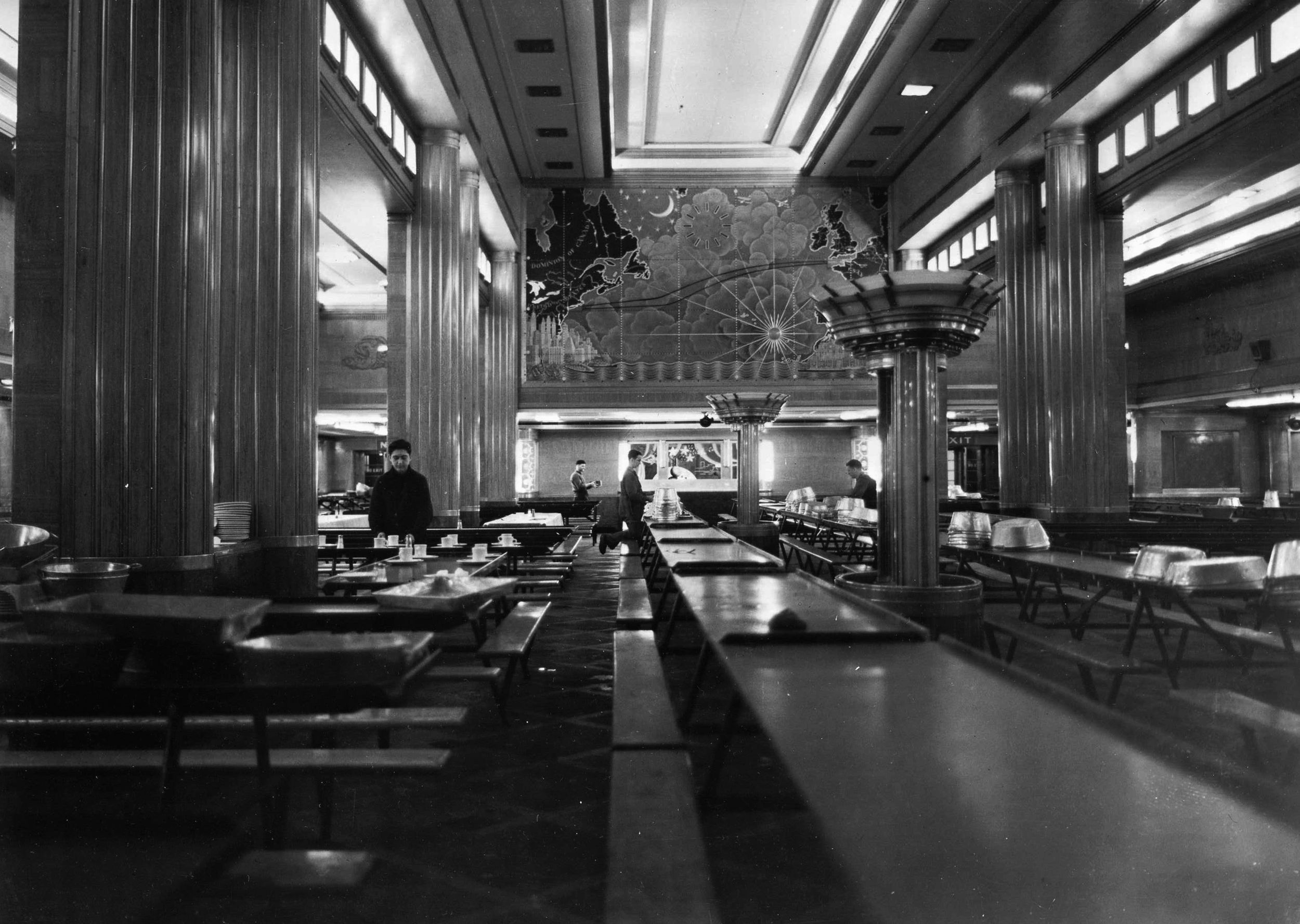
The rest of the trip was uneventful, and the Queen Mary successfully reached Australia, where the Americans disembarked safely. The Yanks had behaved themselves but left distinctively American “calling cards”—wads of chewing gum stuck from stem to stern. Captain Bisset quickly revised the rules, adding chewing gum to the list of banned substances.
A GI Shuttle in the European Theater
By 1943, planning for Operation Overlord, the Allied invasion of occupied France, was well underway. Earlier refitted to accommodate 15,000 men, the Queen Mary made a significant contribution to the Allied build-up that preceded the invasion. In essence, the ship could carry an entire division across the ocean in less than six days.
Now permanently assigned to the European Theater, the giant vessel became a “GI shuttle” that ferried thousands upon thousands of American and Canadian troops across the Atlantic to Great Britain. It was decided that the Queen Mary could take 15,000 men only during the summer months, when the seas were calmer. The ship might weather choppy seas or a raging winter storm, but the packed men would be so tossed about that broken arms and other injuries could result. The idea was to deliver the men in one piece!
Gourock, Scotland, not far from where she was launched, was slated to be the Queen Mary ’s home port for the duration. Southampton was the liner’s normal base in peacetime, but it was too near German-occupied France and subject to enemy air raids. Liverpool was another alternative, but it had also experienced German bombing. Gourock was beyond reach to all but a handful of German long-range aircraft types.
A Good Night’s Sleep on the Transatlantic Voyage
It was quickly realized that new rules and new procedures had to be adopted for the 15,000-man voyages, or all would dissolve into chaos. The ship was divided into three vertical sections—Red, White, and Blue—and every soldier coming aboard was given a colored button corresponding to the section where his unit was assigned. Visiting other sections was strictly forbidden. The Red section stretched from the bow of the ship aft to the number three stairway, excluding the sun deck. White covered everything between number three and number four stairways, and included the sun deck. Blue was from the number four stairway to the stern.
This overcrowding was feasible thanks in part to the standee bunks, which had replaced the ship’s earlier hammocks. Standee bunks were tiered sleeping spaces stacked up as high as six feet. There was only an 18-inch clearance between each standee, which did not help any soldiers who might be claustrophobic. Sleeping was done on a rotation basis, with each bunk shared by the men. In addition, at any given time one-third of the troops would sleep “topside” on the open deck.
The rotation system assured that each man slept inside two nights and then outside two nights. Sleeping topside was feasible only in the summer months because winters on the North Atlantic are too cold. Most GIs actually preferred outside, which was less dank and claustrophobic. Besides, the men reasoned rightly that those topside would have a better chance for survival if the ship was torpedoed.
Sergeant Jerry Cerrachio got some good advice during one of the Queen Mary ’s outbound voyages to Britain. Since the upper standees were fairly high, it was only natural to select a lower bunk for convenience. “Don’t take that one, Sarge,” a friend cautioned. “If one of the guys above you throws up, it’ll wind up all over you!” Cerrachio immediately changed his mind and picked an upper bunk.
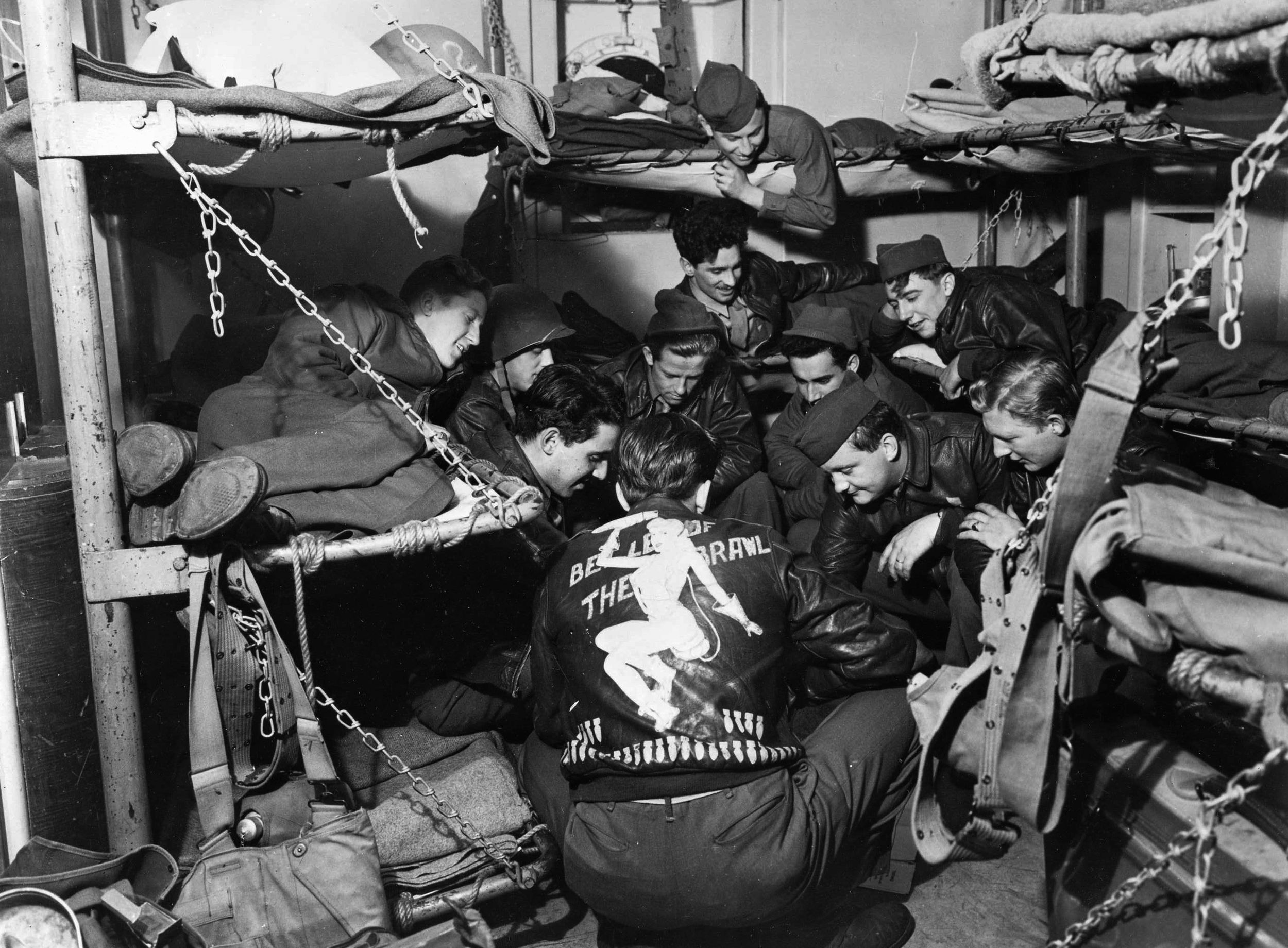
Rules and Regulations
Feeding such a multitude was no easy task. There were two main meals a day in six staggered sittings. Breakfast was available from 6:30 am to 11:00 am, and dinner from 3:00 pm to 7:30 pm. Soldiers could take as much as they wanted but were allotted only 45 minutes to complete their meals. As one group was exiting, another group would be queueing up to be served. Sandwiches were available for the men to take with them as they exited, to snack on between meals.
The former first-class dining saloon was the main enlisted men’s mess hall. It had been stripped of its prewar finery, but the great world map of earlier days was still in place, a reminder of happier times. Officers ate in the former tourist class lounge. Rank did have some privileges. Officers dined on regular tables and had food served by stewards. However, there was literally no “free lunch.” At the end of the crossing, it was expected that an officer would give the stewards a generous tip.
On such a crowded ship, rules and regulations assumed even greater importance. The Queen Mary officially was declared a “dry” ship—no alcoholic beverages allowed. Some rules were almost impossible to enforce. There was to be no swearing, no obscene or profane language, and above all no gambling of any kind. The GIs ignored the gambling ban, and probably drove the MP’s to distraction. Poker, blackjack, and crap games were a major form of amusement during the long six-day passage.
Some rules were rigidly enforced. There was a standing order that all personnel had to wear their life jackets and helmets when topside. Any person caught without these items had to forfeit his shoes. The story is told of an American admiral who must have thought his exalted rank put him above these things. He was caught without a life jacket and forced to surrender his shoes. He padded off in his stocking feet, thoroughly chastened.
Clandestine gambling apart, there was little to do on these long, cramped voyages. There was an occasional work detail, and some officers arranged exercise workouts. Movies were shown, but the Queen Mary ’s film library was limited. At least the GIs were aboard for only six days. Cunard crew members had even less choice. It was said that one crewmember saw the Laurence Olivier film, Pride and Prejudice , 120 times!
Other soldiers passed the time by reading, writing letters, or simply talking to buddies. Those seeking religious solace could attend services in the Catholic, Protestant, or Jewish chapels. Mandatory lifeboat drills, ironic in that there were not enough lifeboats to accommodate all, also provided some breaks in the monotony.
The Stench of Seasickness
Life may have been tolerable, but it was anything but a pleasure cruise. The RMS Queen Mary was a legendary ship in any guise, even a troopship, but even before the war it had a tendency to roll in heavy seas. This was an unfortunate trait in the North Atlantic, well known for centuries as one of the most treacherous, even capricious, oceans in the world.
Seasickness was common, and the men rarely washed. There was always a lurking fear that one would be caught in the shower when the ship was torpedoed. Rather be dirty and safe than be clean and sorry. The net result was an atmosphere of cigarette smoke, sweat, vomit, and diesel oil that cannot be imagined by merely looking at period photographs.
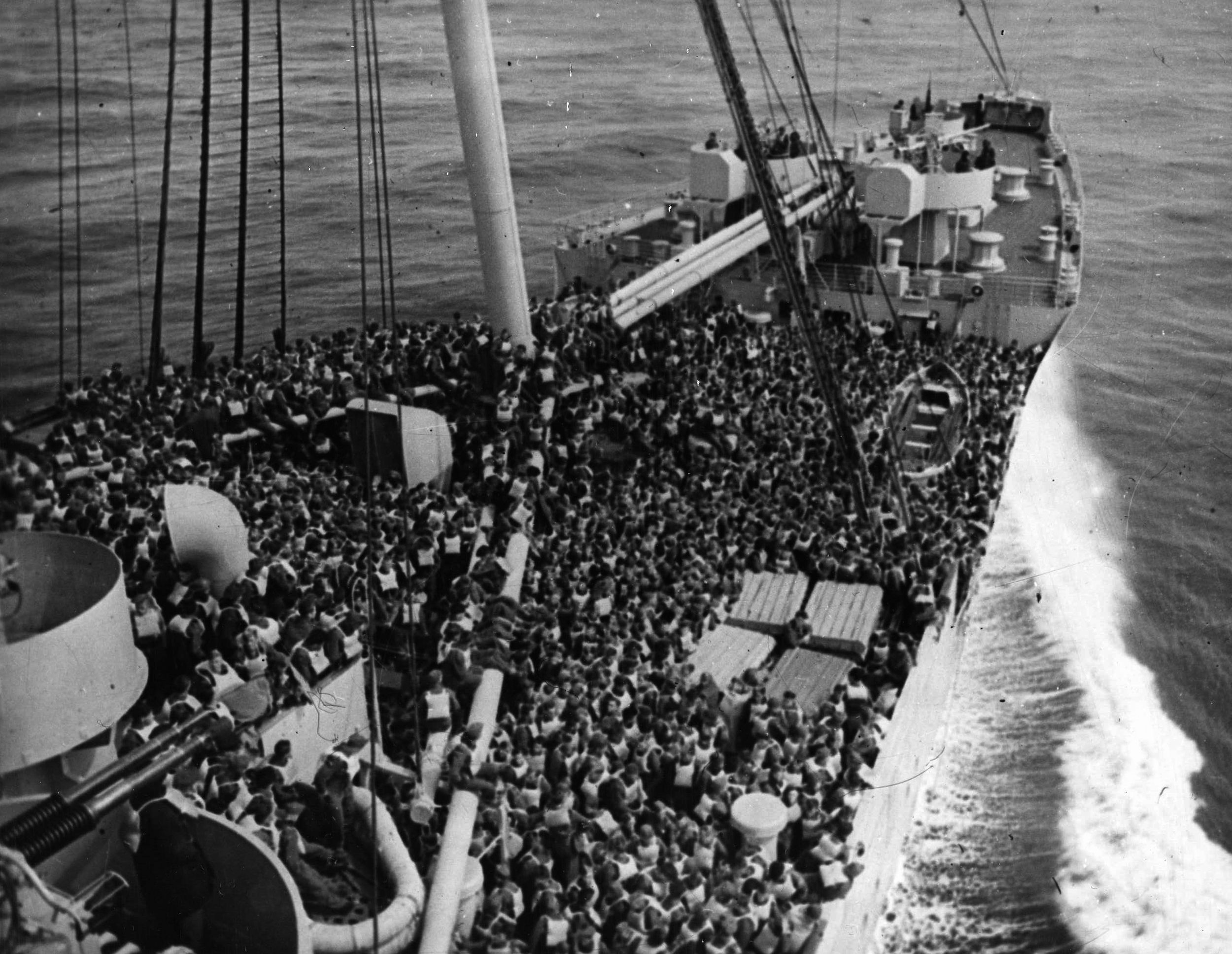
The Queen Mary ‘s Wartime Successes
In spite of the problems and discomforts, the Queen Mary was succeeding in its mission. During August 2 through 7, 1942, the ship carried a complete division, the First Armored, across the Atlantic. On that voyage, 15,125 troops and 863 crewmen were aboard. The ship reached a milestone on the July 25-30, 1943, passage. On that voyage she transported 15,740 troops and 943 crewmen, for a grand total of 16,683. It was the largest number of people ever carried by a steamship.
The Queen Mary also transported Axis POWs during her years of active service. Early in the war, the ship transported Italian prisoners to Australia. After the tide turned in North Africa, thousands of Germans also found themselves involuntary passengers aboard the great liner. Winston Churchill was aboard the Queen Mary for three trips, and during one of these voyages the liner also carried 5,000 German POWS.
On the whole, the Axis prisoners caused little trouble, but occasionally there were some minor flareups. In June 1942, some German prisoners scrawled anti-British slogans on a bulkhead. They were confined to the brig for a few days on bread and water. When some British personnel tried to counter with “Rule Britannia” graffiti, they too were thrown in the brig to cool off for a few days. One did not mark the Queen Mary ’s walls, and the captain was determined not to play favorites!
The Germans would claim to have sunk the Queen Mary from time to time, partly in an effort to locate it. The Germans hoped that the false reports would prompt the Queen Mary or the Admiralty to break radio silence. If they did so, then the Germans could get a fix on the vessel. The British never fell for such a transparent ruse, and throughout the war the Queen Mary led a charmed life.
The HMS Curacao Tragedy
One tragedy did mar the Queen’s otherwise sterling wartime career. It occurred off the coast of Ireland on October 2, 1942, at about 2 pm. Captain Cyril Illingsworth was the ship’s master on this voyage, and at the time he was in the chartroom in the back of the bridge. Navigating officer Stanley Wright remarked to the captain that he felt unhappy that the escorting vessel, HMS Curacao , was getting too close. Illingsworth dismissed Wright’s worries, saying the light cruiser was used to escort duties and she “will keep out of your way.”
At the moment, the Queen Mary was executing a zigzag pattern, standard procedure for protection against submarines. The HMS Curacao was a light cruiser of World War I vintage, 450 feet long and 4,200 tons, commanded by Captain John Boutwood, a regular Royal Navy officer.
Suddenly, the Curacao moved close to the Queen Mary —too close. Recognizing the danger, the Queen Mary ’s senior first officer, Noel Robinson, ordered, “Hard a port!” The horrified officer knew they had only two minutes to rectify the course and heading and to ward off disaster.
It was not enough. The Queen Mary struck the Curacao a glancing blow at an acute angle about 11 feet from her stern, which spun the smaller vessel around 90 degrees and left her vulnerable for a second, more devastating collision. The Queen Mary sliced through the Curacao ’s hull like a knife though butter, cutting the unfortunate cruiser in two amid the sounds of escaping steam and tearing metal. The Curacao ’s stern momentarily half capsized, its propellers spinning in the empty air, before finally disappearing beneath the waves. The front half, consumed in flames, floated a moment or two longer before going under.
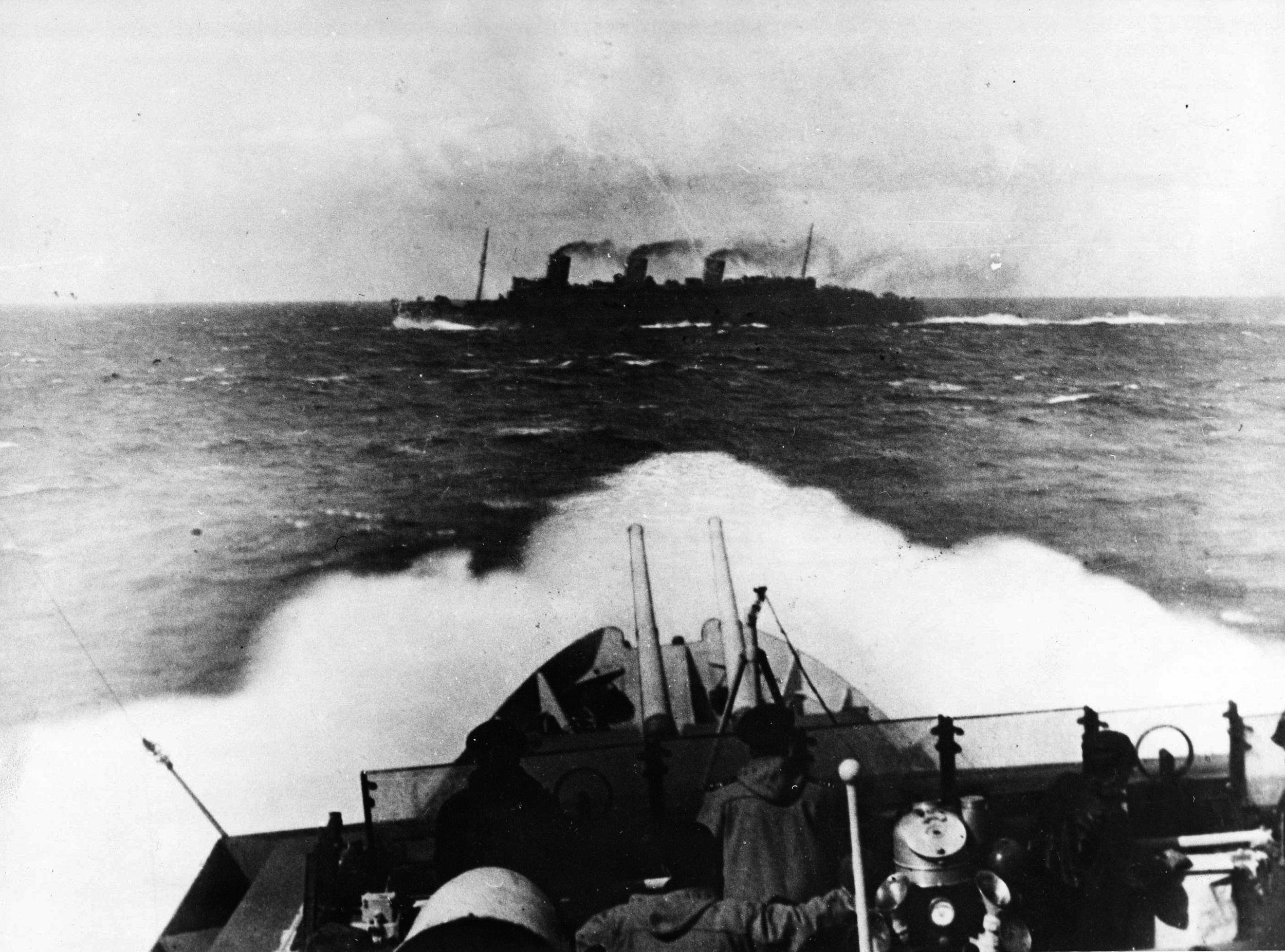
Within seconds, the sea was a thick, viscous mass of oil slicks and screaming, half-dazed survivors. The Queen Mary sailed on without stopping—those were the standing orders—leaving smaller ships to pick up survivors. Only 101 sailors out of a complement of 429 officers and men lived to tell the tale.
Damage control parties quickly examined the Queen Mary ’s bow and found an 11-foot hole at the point of impact. There was serious flooding to the forepeak, but as long as the watertight bulkhead held, there would be no serious danger. Speed was reduced to less than half, about 13 knots. The ship was inspected and deemed seaworthy. There was no need to replace the damaged bow, at least at the time.
The tragedy had been caused by a series of wrong assumptions, small miscalculations, and bad timing thoroughly based on human error. Both captains were men of ability and sound judgment. Though he was not entirely responsible for the disaster, Captain Illingsworth automatically thought that the Queen Mary would have the right of way. It was a fatal assumption.
The RMS Queen Mary ‘s Long Voyages of World War II
The RMS Queen Mary then embarked on one of the greatest troop delivery shuttles in her career. Dubbed the “long voyage,” the vessel went from Scotland, to Suez, and to Sydney, Australia, and then returned to Gourock. Total round trip mileage was 37,943 miles.
The Queen Mary and her sister ship, Queen Elizabeth , were a vital part of the war effort. Indeed, many claim they helped shorten the war by about a year. Without the massive buildup provided by the Queens , D-Day might have been postponed until 1945. Between June 1943 and April 1945, the Queen Mary carried nearly 340,000 American and Canadian troops on journeys that covered 180,000 miles. The political consequences were immense. If the Western allies had been delayed, Stalin’s Red Army might have spread Communism beyond the reaches of Eastern Europe.
It was Winston Churchill who summed up the matter best. “Built for the arts of peace and to link the Old World with the New,” he later wrote, “the Queens challenged the fury of Hitlerism in the Battle of the Atlantic. Without their aid, the day of final victory must unquestionably have been postponed.”
Eric Niderost is a college professor in Hayward, California.
Back to the issue this appears in
Join The Conversation
7 thoughts on “ rms queen mary’s war service: voyages to victory ”.
Hi Eric… Thank you so much for your well researched information on the Queen Mary.
I have a shoe box of memorabilia and souvenirs collected by my uncle, Leslie Jack Connolly, throughout his life. I came across a postcard of the H.T Queen Mary and two menus from the officer mess, dated January 1941, and just had to find out why he had collected these items. I knew he had been in the Australian Army and I also knew he had served in the Middle East and now I know how he got there. He left Sydney, Australian on the Queen Mary at the end of December 1940, or the beginning of January 1941 and arrived in Trincomalee, Sri Lanka on the 31 January, 1941. His brother Eric Sydney Connelly was also with him. So thank you again for your information on the Queen Mary. Regards Vicki
I just came across a letter from my father, John Oliver Fletcher, to a family friend, detailing his war time experiences as a pilot in the RAF. As a side note at the end of the letter, he left this comment: “The stamp on your envelope is interesting. It shows the very first building that I ever saw in Canada after leaving the Queen Mary with a hole in it at Boston before heading for New Brunswick.” I have vague memories of my father describing the tragedy and the result… but did not have any real idea what a big deal it was, as he tended to brush things off, I think, as a way to make them easier for us to understand. Much of the emotional toll of war was not communicated, but he did refuse to ever go on any type of vacation cruise, saying that they were a waste of money. I now understand that there was much more behind that stance than he was able to communicate. Thank you for your detailed article enabling me to better understand who my father was long before I arrived.
Hi Vicki – We would love to hear more about your uncle’s connection with the RMS Queen Mary and maybe able to help provide more detail of his time onboard the ship. Please reach out if interested. [email protected] – Foundation for the RMS Queen Mary ( http://www.Qmi.care ) Thank you
My dad was a sailor on the Queen Mary I around 1944-1945. He remembers ferrying American troops across the Atlantic. Interesting to hear about the history of the ship.
Hi Pauline – We would love to hear more about your Dads’s connection with the RMS Queen Mary and maybe able to help provide more detail of his time onboard the ship. Please reach out if interested. [email protected] – Foundation for the RMS Queen Mary ( http://www.Qmi.care ) Thank you
1944, I was 4 on holiday at the Isle of White. I grew up with the memory that a man on horseback rode along the beach telling everyone to get out of the water as the Queen Mary was either coming or going out of Southampton. Could this be a true memory.
My dad, Joseph Kohout, was with the Battery B, 743rd Battalion, Coastal Artillery (AA), when his unit was one of several on the QM during its ’40 Days & 40 Nights’ voyage, 2/18/42-3/28-42. He ended up in New Guinea with Aussie units as an AA gunner. Said he remembered the Rio de Janeiro port call. Said the troops on the QM were issued surplus WWI kapok life jackets which were mostly no good when they had a pool filled with water to test them. Kapok tree floss inside had deteriorated! Lost its ‘buoyancy’; didn’t help morale much! Also said he was trained to shoot down German/Italian planes and thought he was being sent to Britain, not the South Pacific, and had to learn Japanese plane silhouettes and markings once he got there.
Leave a Reply Cancel reply
You must be logged in to post a comment.
Share This Article
- via= " class="share-btn twitter">
Related Articles
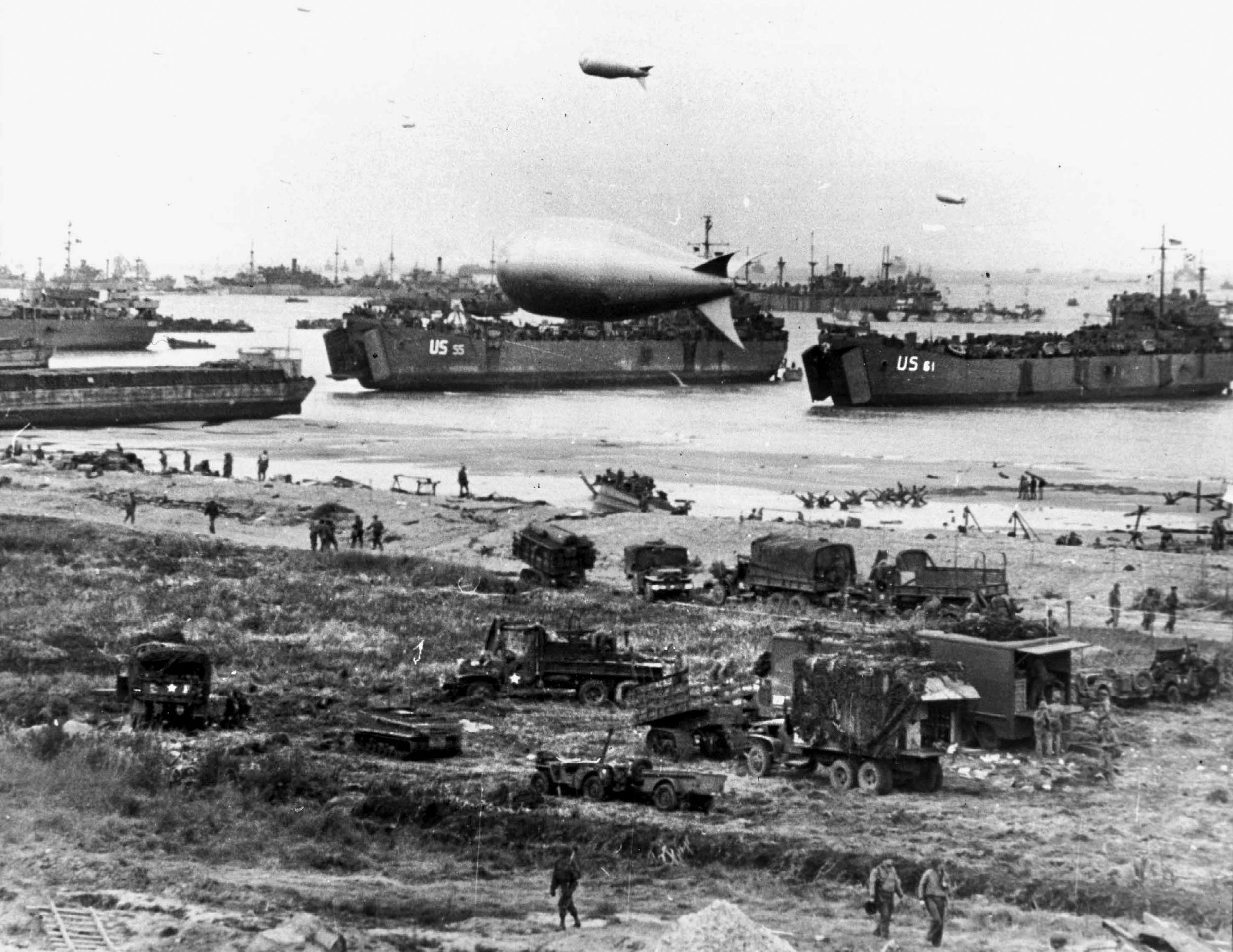
Julius Boreali in Operation Overlord
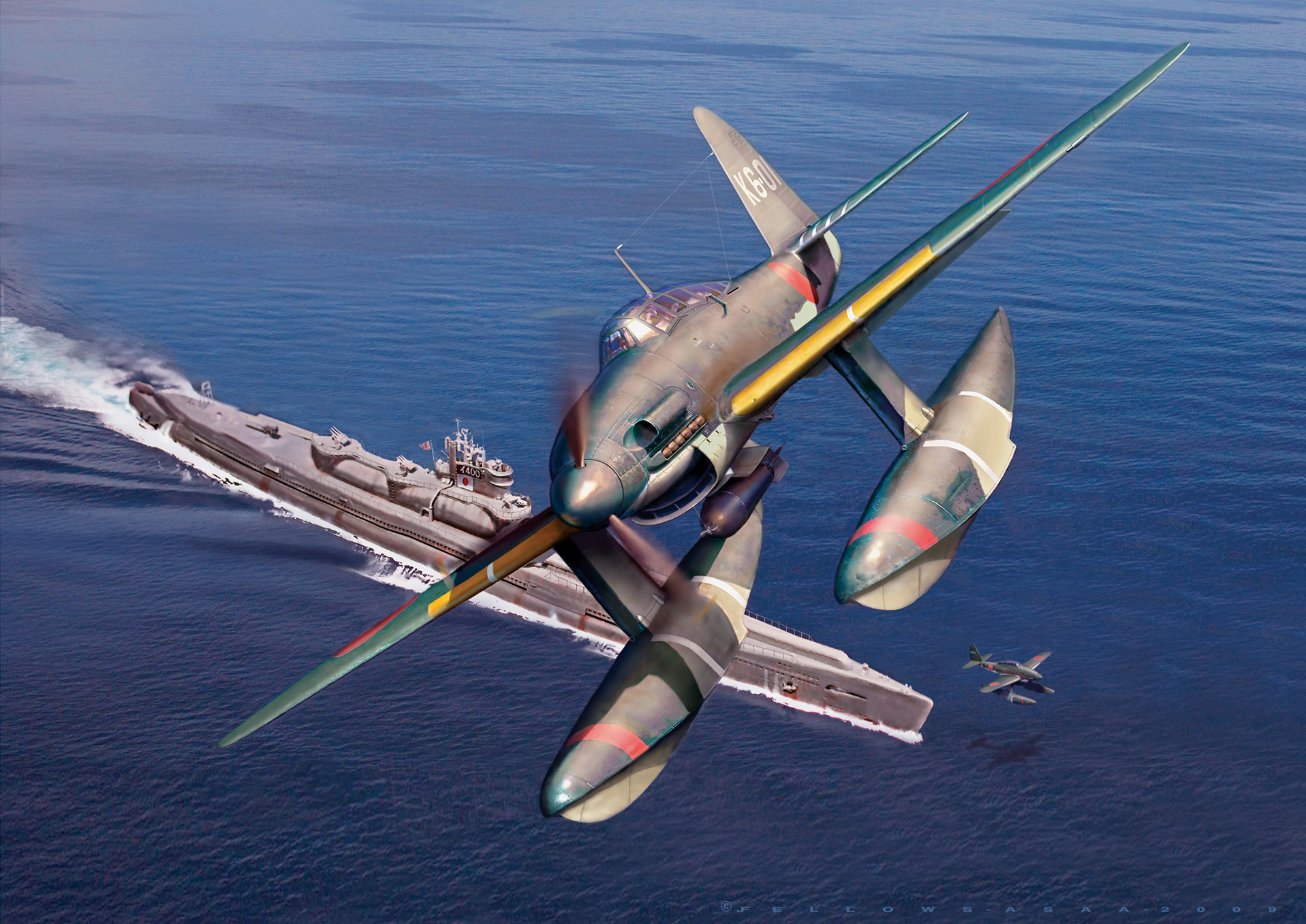
Japan’s Underwater Aircraft Carriers
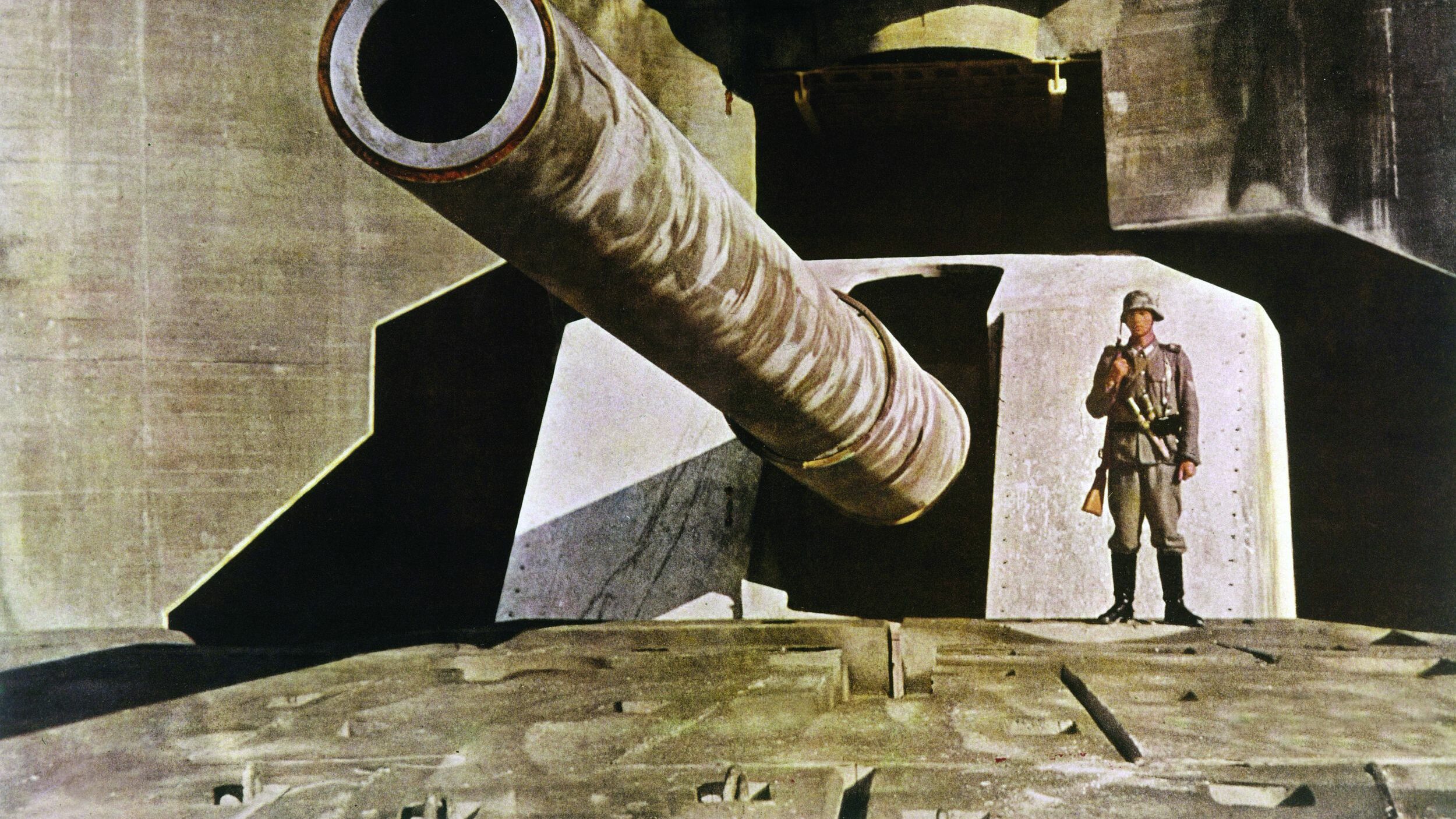
Building the Atlantic Wall

What happened to fighter pilot Grant Stout?
From around the network.
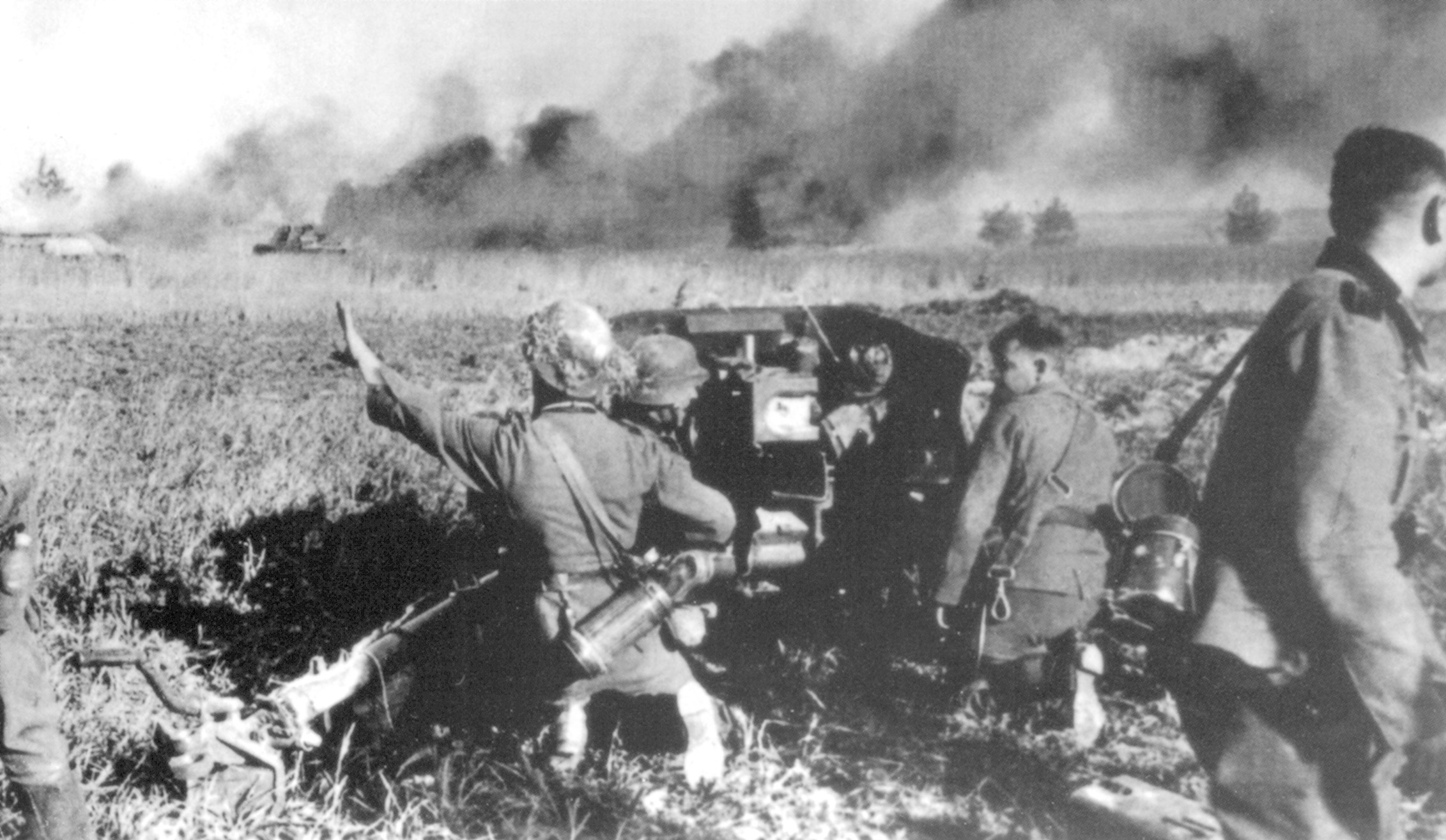
Red Army Generals: Ivan D. Chernyakhovsky
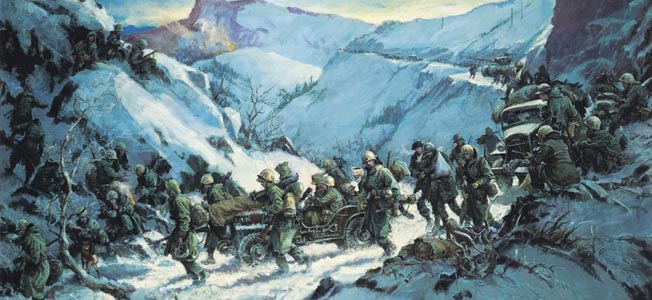
Military History
Americans Faced Blown Out Bridge During Retreat To 38th Parallel
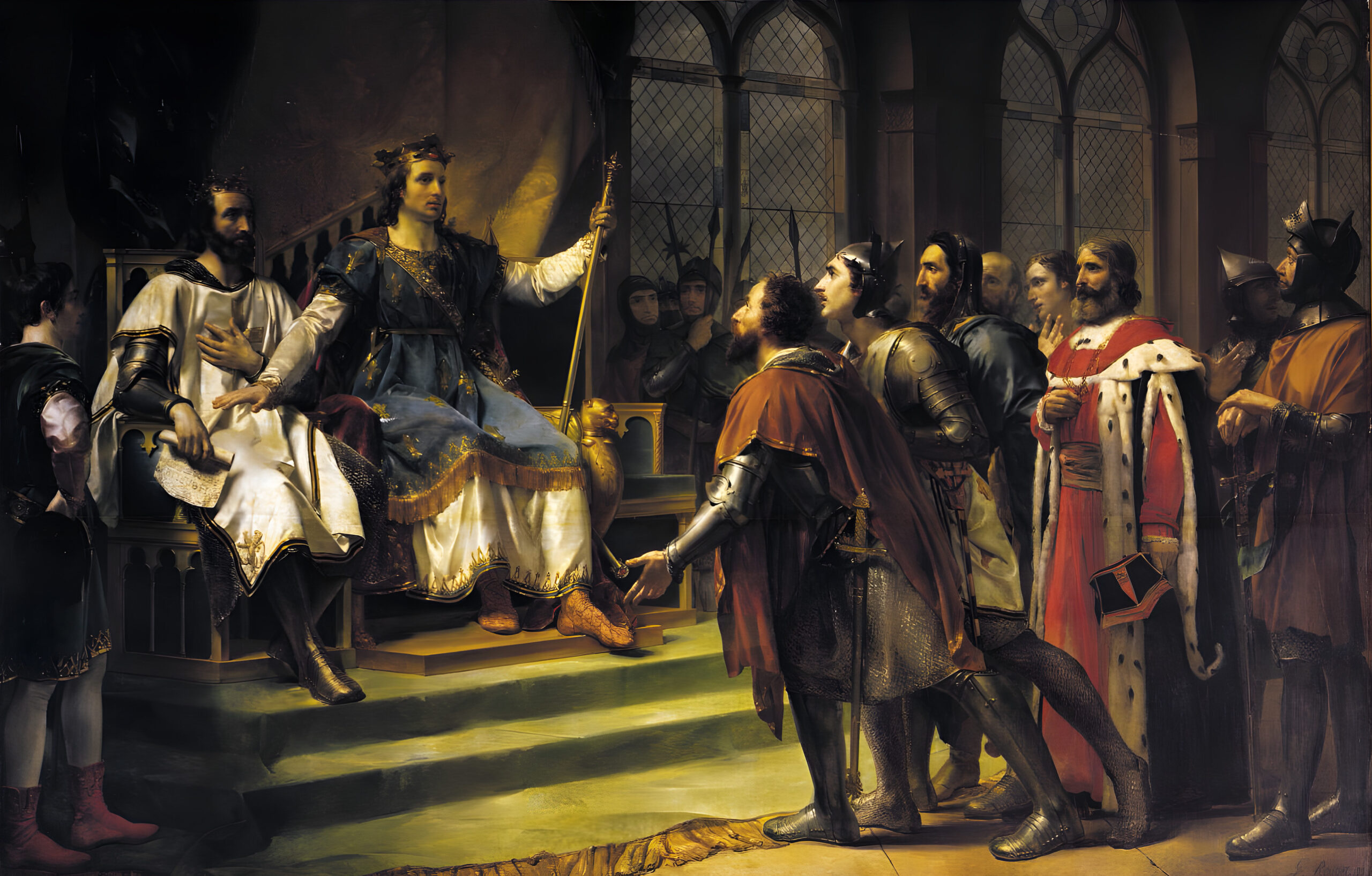
Thundering Clash at Lewes
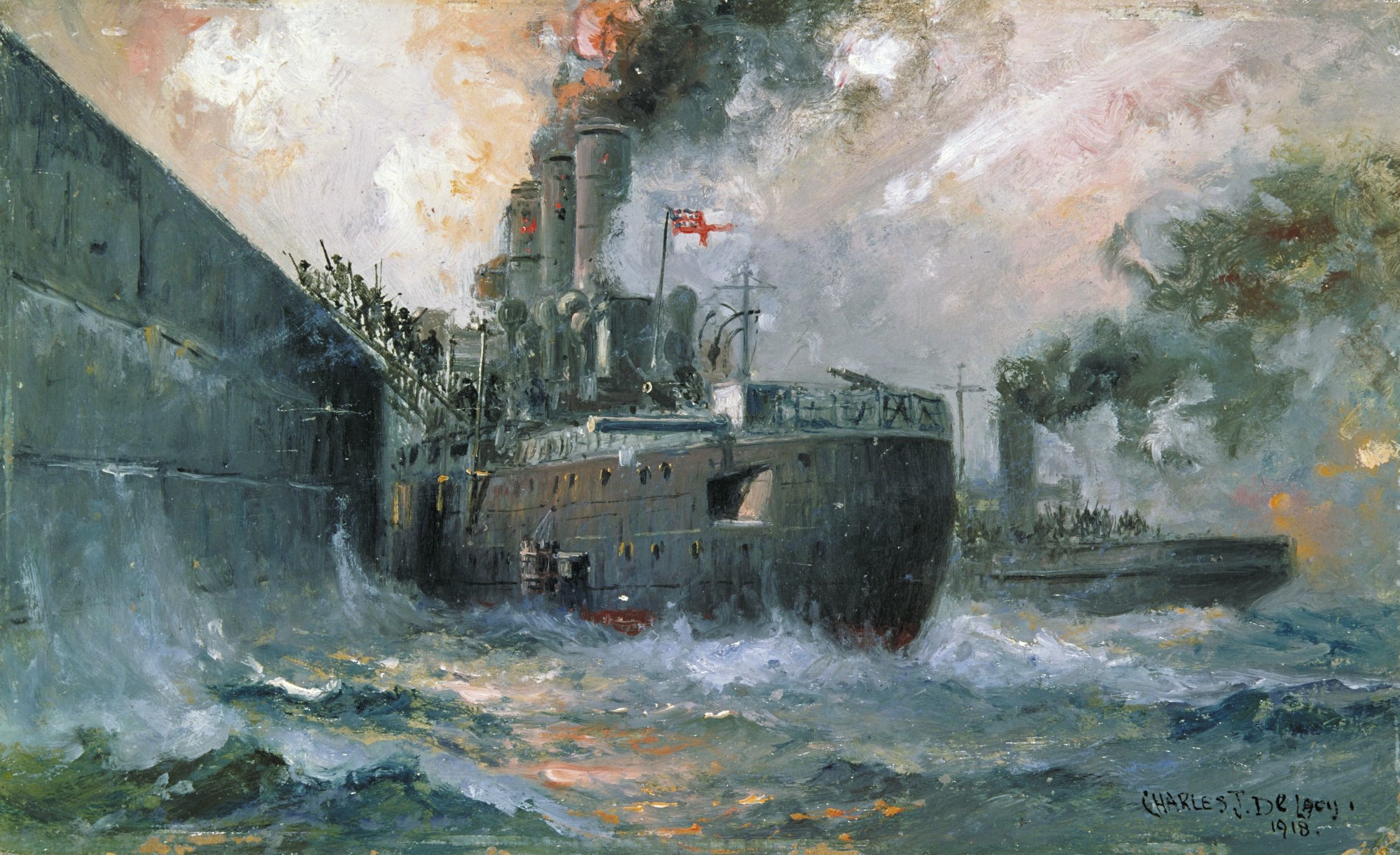
Zeebrugge: A Gallant Raid on Saint George’s Day
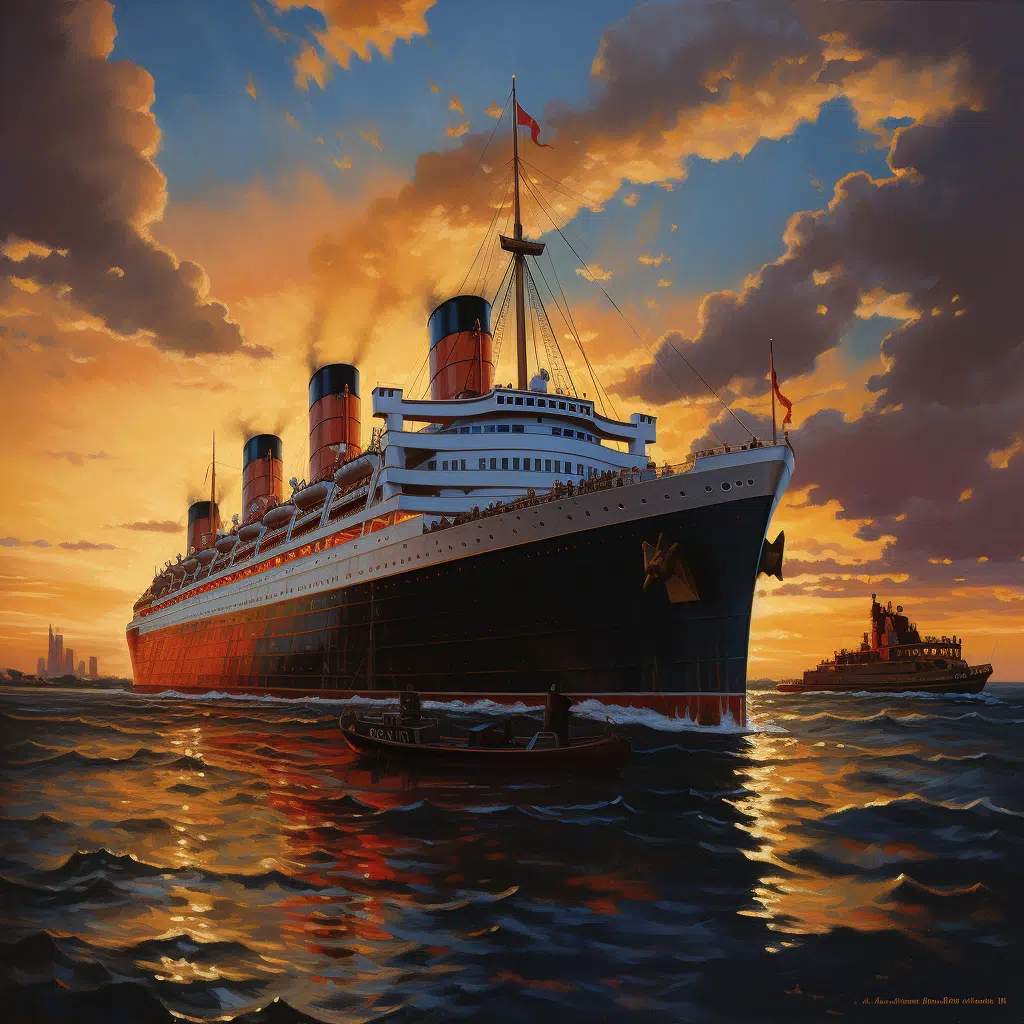
- Destinations , Lifestyle , Travel
Rms Queen Mary’s Iconic Voyage Legends
- Navigate Magazine
Steaming Through History: RMS Queen Mary’s Maiden Voyage
Picture it: May 27th, 1936—RMS Queen Mary sets off on her maiden voyage. The air buzzes with anticipation, the champagne sparkles, and the golden age of transatlantic travel adds another star to its glittering firmament. As she steamed out of Southampton, every inch of this magnificent ocean liner announced a new era of luxury travel. RMS Queen Mary wasn’t merely a ship; she was an Art Deco masterpiece, a floating embodiment of the cutting-edge.
Patrons clad in their finery wandered among her decks, marveling at the ship’s revolutionary design. Innovations were plenty, from the streamlined hull that cut through the waves like a silver knife to the grand dining rooms, where the finest meals were served with impeccable flair. The RMS Queen Mary stood not just as transport, but as a testament to mankind’s relentless pursuit of progress and luxury, qualities etched into her very steel.
Navigating the Seas of War: The Queen’s WWII Service
With World War II’s outbreak, the Queen Mary’s silver paint was cloaked in warship gray, and her grandeur gave way to gritty determination. Dubbed the “Grey Ghost” because of her stealth and stark color, she was transformed into the fastest troopship to sail, whisking as many as 16,000 troops at a blistering 30 knots. Her speed was her shield , her agility a whisper of hope in dark times.
Veterans recall sneaking glances at the horizon, uncertain of their fate, yet comforted by the Queen Mary’s steadfast presence. Accounts of her daring evasions of enemy submarines and aircraft read like something straight out of a thriller, only, these tales are firmly anchored in reality—underscored by the faded RMS Queen Mary photos of young soldiers lining her decks.
RMS Queen Mary The World’s Favourite Liner
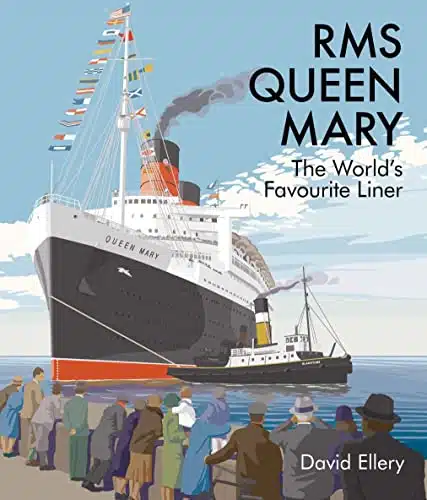
The RMS Queen Mary stands as a testament to the opulence and grandeur of the golden age of ocean travel, captivating the imagination of maritime enthusiasts and history buffs alike. Launched in 1936, this illustrious ocean liner was the pride of the Cunard Line and heralded as a marvel of engineering and luxurious design. With her sleek, Art Deco interior and unparalleled elegance, the Queen Mary transcended mere transportation, offering an experience that epitomized the romance of sea voyages. Throughout her active years, she ferried countless passengers across the Atlantic, including illustrious celebrities, dignitaries, and even troops during wartime, cementing her legacy as the world’s favourite liner.
The RMS Queen Mary’s construction benefitted from the finest craftsmanship of the era, blending state-of-the-art technology with unrivaled luxury. Her impressive facilities included a grand ballroom, a swimming pool, exquisite dining areas, and lush cabins, each reflecting the epitome of style and comfort. During her years of service, the queen of the seas set speed records that contributed to her fame, and her reliability and performance made her a cherished symbol of British maritime prowess. Now retired, she serves as a floating hotel, museum, and event venue, allowing visitors to step back in time and relive the golden age of ocean travel.
Retired and docked permanently in Long Beach, California, the RMS Queen Mary continues to enchant visitors with her historical splendor. As a preserved historical site, guests can explore her decks, cabins, and engine rooms, embarking on various tours that recount her illustrious past. Her legacy is further celebrated through numerous events, exhibitions, and ghost tours that pay homage to the legends surrounding the iconic vessel. The Queen Mary isn’t just a relic; she’s a narrative that continues to unfold, inviting new generations to explore the story of what was once the world’s favourite ocean liner.
The Glamour and the Ghosts: RMS Queen Mary’s Record-Breaking Passengers
After the guns fell silent, the Queen Mary once again unfurled her sails of luxury. The stars returned: the cast of “Gilligan’s Island” might well have admired the view just as you can at Silverscreenmagazine.com/gilligans-island-cast/ , and icons like Bo Derek added to the ship’s allure, mirroring her timeless grace Twistedmagazine.com/bo-derek/ ). The RMS Queen Mary cruised into legend, a mirror of the society’s golden echelons, complete with whispers of specters echoing in her halls.
The luxurious fittings that once caught the eye now played host to murmurs of the supernatural—with RMS Queen Mary photos capturing the grandeur of the setting where visitors report ghostly occurrences. It’s said that more than 150 ghosts have made the Queen Mary their eternal abode, a chilling footnote to her legacy.
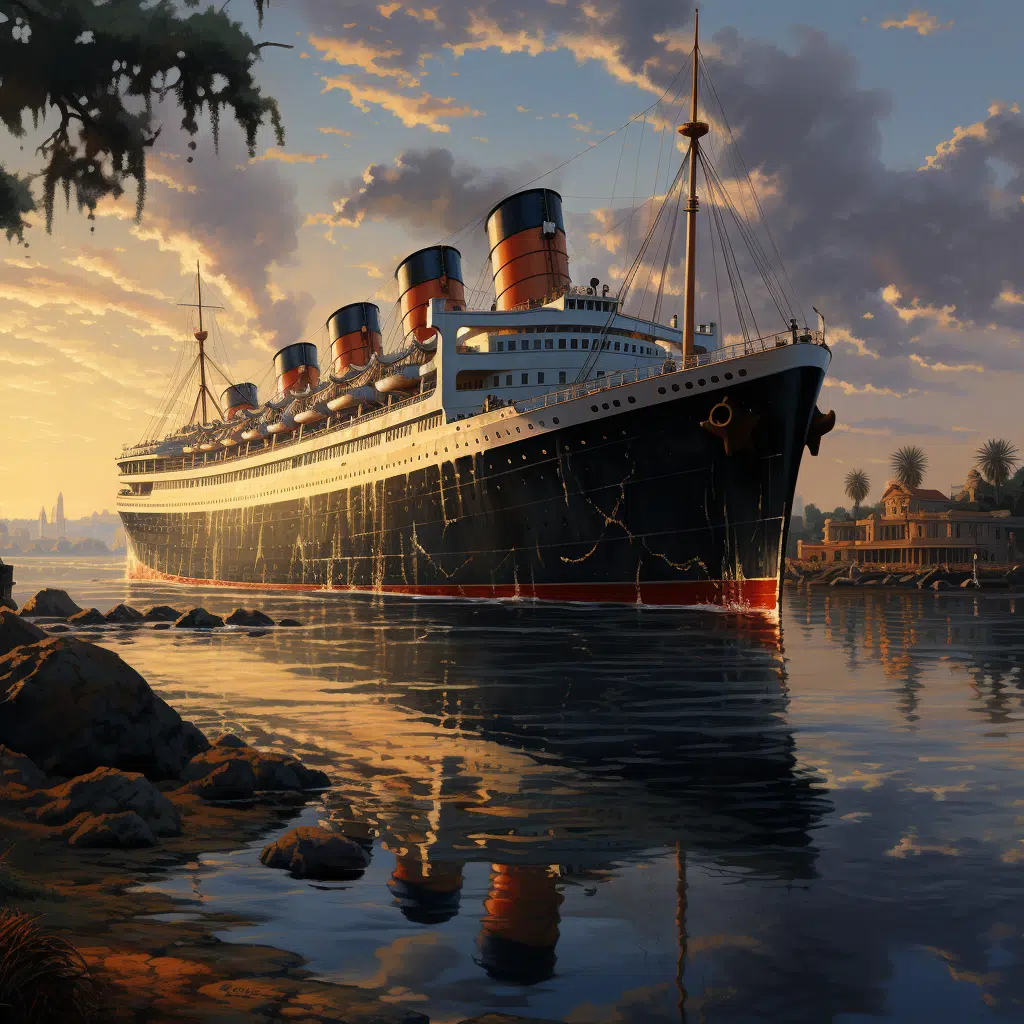
Romance on the High Seas: Notable Weddings Aboard the RMS Queen Mary
The Queen Mary didn’t just transport people; she was a sailboat for dreams, a venue where couples exchanged vows with the Atlantic whispering its blessings. The allure of matrimony aboard this colossal vessel can’t be understated, giving rise to weddings that were as much a journey as a destination.
Imagine reciting your vows surrounded by history and sea, where every knot tied was not just of rings but also of the countless stories the Queen Mary harbored. These weddings were wrapped in the romance of the past, fashioning a nostalgia that still resonates, celebrating love as expansive as the oceans she sailed.
Charting a New Course: Movie Sets and Cultural Transitions
The RMS Queen Mary had a knack for drama, making her a natural for the silver screen. She’s been a backdrop for narratives of all shades, her tapestries and teak decks serving as silent characters in various cinematic tales. But her most poignant role began in 1967 when her final voyage ended in Long Beach, California, transforming her from queen of the seas to a static bastion of history and culture.
This transition wasn’t simple—a feat as complex as her engineering—but vital to preserving not just a ship but a chapter of human achievement. In Long Beach, the City embraced her as a museum, hotel, and restaurant, a multi-faceted tourist attraction showcasing a bygone era’s allure.
RMS Queen Mary Model Foot in Length
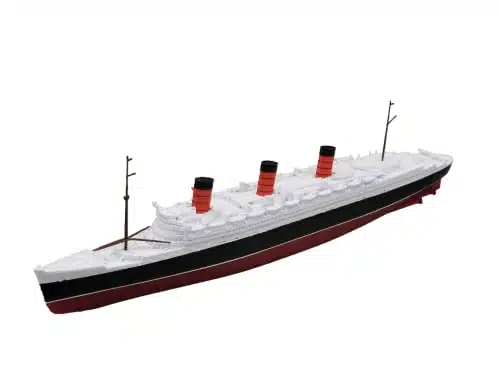
The RMS Queen Mary Model is a meticulously crafted representation of the legendary ocean liner that boasts an impressive one-foot length, capturing the grandeur of the original vessel in a compact, display-friendly size. This scale model is an exquisite piece designed with intricate details, from the carefully painted hull to the minute superstructure details, making it a must-have for maritime enthusiasts and model collectors alike. Using high-quality materials to ensure durability and authenticity, the model presents an accurate silhouette that reflects the RMS Queen Mary’s classic lines and elegant design, inviting onlookers to step back into the golden age of ocean travel.
Each aspect of the RMS Queen Mary Model has been considered with an eye for historical accuracy, incorporating features such as the iconic funnels, expansive promenade decks, and the intricate railing and lifeboats that defined the original ship. Even the smallest embellishments, like the hand-applied windows and meticulously recreated deck furniture, are designed to showcase the ship’s legacy. The attention to detail extends to the application of the vessel’s livery, represented here with precision to mirror the original paintwork and the famous Cunard Line insignia.
The RMS Queen Mary Model comes complete with a sturdy display stand, allowing collectors to exhibit the model as a centerpiece in their collection or as an elegant desktop display. As a celebration of the ship’s historical significance and a testament to its enduring legacy, this model will not only be a conversation piece but will also serve as an heirloom that captures the imagination and admiration of naval history buffs for years to come. Whether placed in a home, office, or aboard a modern seafaring vessel, the RMS Queen Mary Model at one foot in length is an exquisite tribute to one of the most famous ocean liners ever to grace the seas.
Underwater Elegance: RMS Queen Mary’s Art Deco Interiors
Step inside the RMS Queen Mary, and you’ll feel like you’ve plunged into the pages of a Gatsby novel. Her Art Deco interiors are a marvel, a masterclass in design that encapsulates a period of unbridled opulence. Every room from the grand saloon to the intricate first-class suites is a time capsule, showcasing:
- Geometric elegance.
- Bold lines.
- Exquisite workmanship.
Preservationists and experts, akin to those restoring the best mattress for a dreamy sleep at Neuronmagazine.com/best-mattress/ , toil to maintain the authenticity of these spaces. These Art Deco interiors are not just rooms; they’re sanctuaries of style, standing testament to a golden era’s craftsmanship and vision.
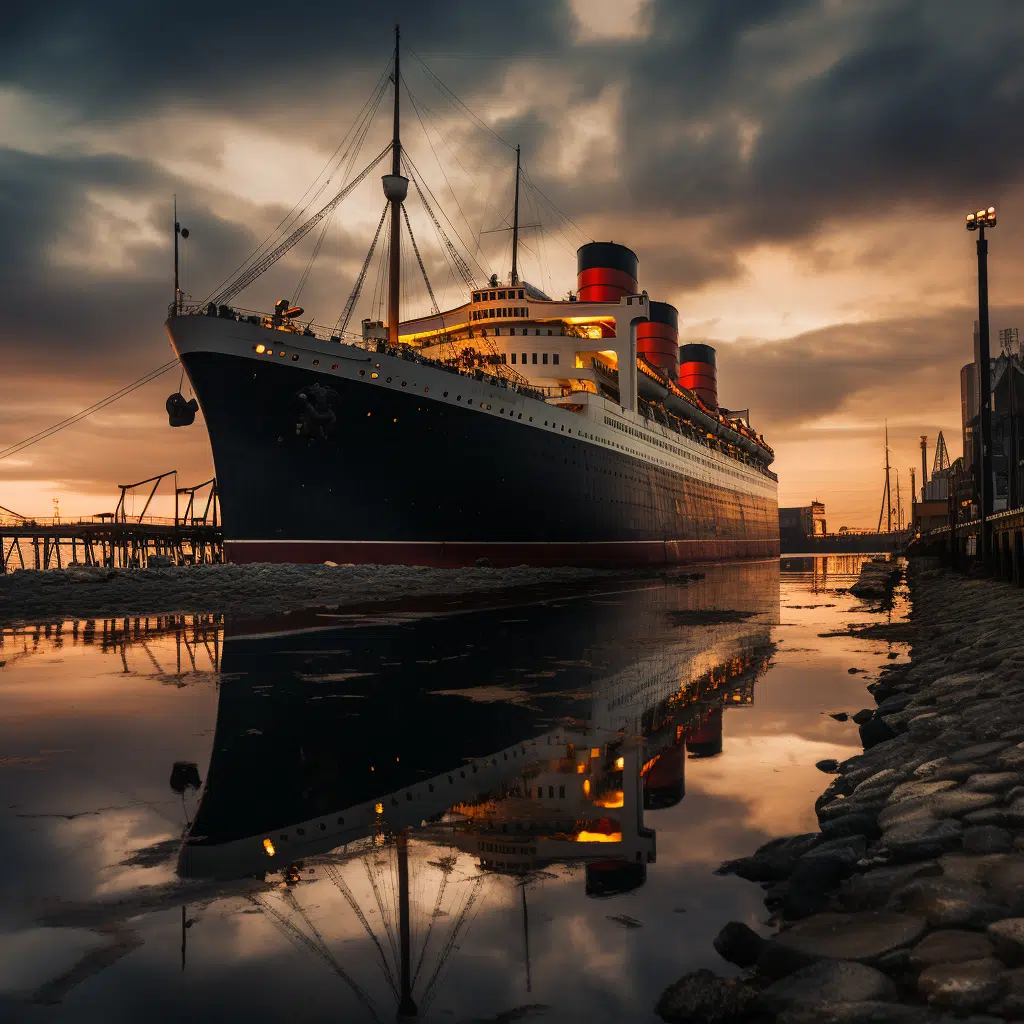
A Haunting Voyage: Exploring the Supernatural Claims
Oh, the stories she could tell—if only her polished wood panels could speak! From the harmless antics of a spectral little girl to the more somber presence felt in the depths of the engine room, the paranormal claims aboard the RMS Queen Mary are as varied as they are spine-tingling.
Some say it’s the history that hangs heavy in the air, a veritable breeding ground for the supernatural. Guests and staff, with tales as captivating as any ghost story told by the fireside, have reported eerie encounters that add a layer of otherworldly intrigue to the maritime marvel.
Preservation and Legacy: Keeping the RMS Queen Mary Afloat
Like any grande dame of a certain age, the RMS Queen Mary requires tender loving care to stay resplendent. Preservation is an epic, ongoing saga fraught with financial and logistical quagmires. But like buoyant lifeboats in a tempest, community groups and passionate organizations rise to the challenge, their efforts a tribute to the ship’s historical and cultural significance.
This labor of love is driven by the belief that preserving the RMS Queen Mary is crucial—not just for nostalgia’s sake but as a beacon of history’s lessons and achievements for tomorrow’s adventurers.
Memories of Mary The RMS Queen Mary in Pictures Volume V
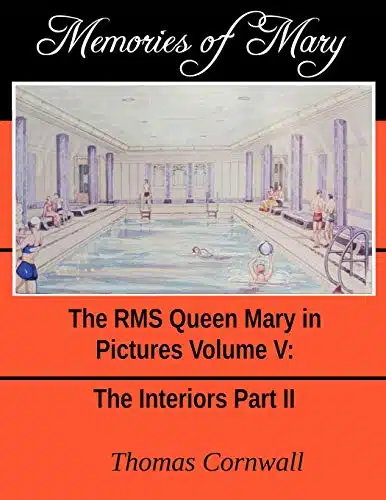
“Memories of Mary: The RMS Queen Mary in Pictures Volume V,” is a captivating visual journey that invites readers to experience the grandeur and elegance of one of the most celebrated ocean liners of all time. This fifth volume in a series of pictorial retrospectives meticulously assembles rare and previously unpublished photographs that bring to life the ship’s storied past. With a foreword written by a historian specializing in maritime history, this book offers insightful commentary and context that enriches every page.
As readers turn through the collection, they are treated to snapshots of the Queen Mary’s illustrious servicefrom her heyday in the 1930s and ’40s, ferrying celebrities and dignitaries across the Atlantic, to her transformation into a troopship during World War II. The images chronicle the evolution of seafaring elegance and technology, capturing the essence of an era where ocean travel was the pinnacle of luxury. Close-up shots of the ship’s fittings, artworks, and opulent interiors, along with candid moments of crew and passengers, provide an intimate look at life onboard.
This edition not only showcases the grandeur of the vessel but also pays homage to the enduring spirit of the RMS Queen Mary, now a floating hotel and museum anchored in Long Beach, California. Nostalgia enthusiasts and maritime collectors will find “Memories of Mary: The RMS Queen Mary in Pictures Volume V” an essential addition to their libraries, offering a treasure trove of visual history that celebrates the ship’s remarkable journey through time. Each image is a doorway to the past, inviting reflection on the golden age of ocean travel and the timeless allure of the Queen Mary herself.
Anchored in Education: The RMS Queen Mary as a Learning Opportunity
For the curious mind, the RMS Queen Mary is both a museum and a classroom. Through her educational programs and initiatives, she casts a wide net, capturing the imagination of visitors of all ages. Schools and institutions partner with her to bring to life lessons on maritime history, showing how the Queen Mary charted a course through significant events of the 20th century.
These programs are not just about absorbing facts; they’re about experiencing the epic tapestry of human endeavor, resilience, and innovation—all within the metal and wood confines of this majestic ship.
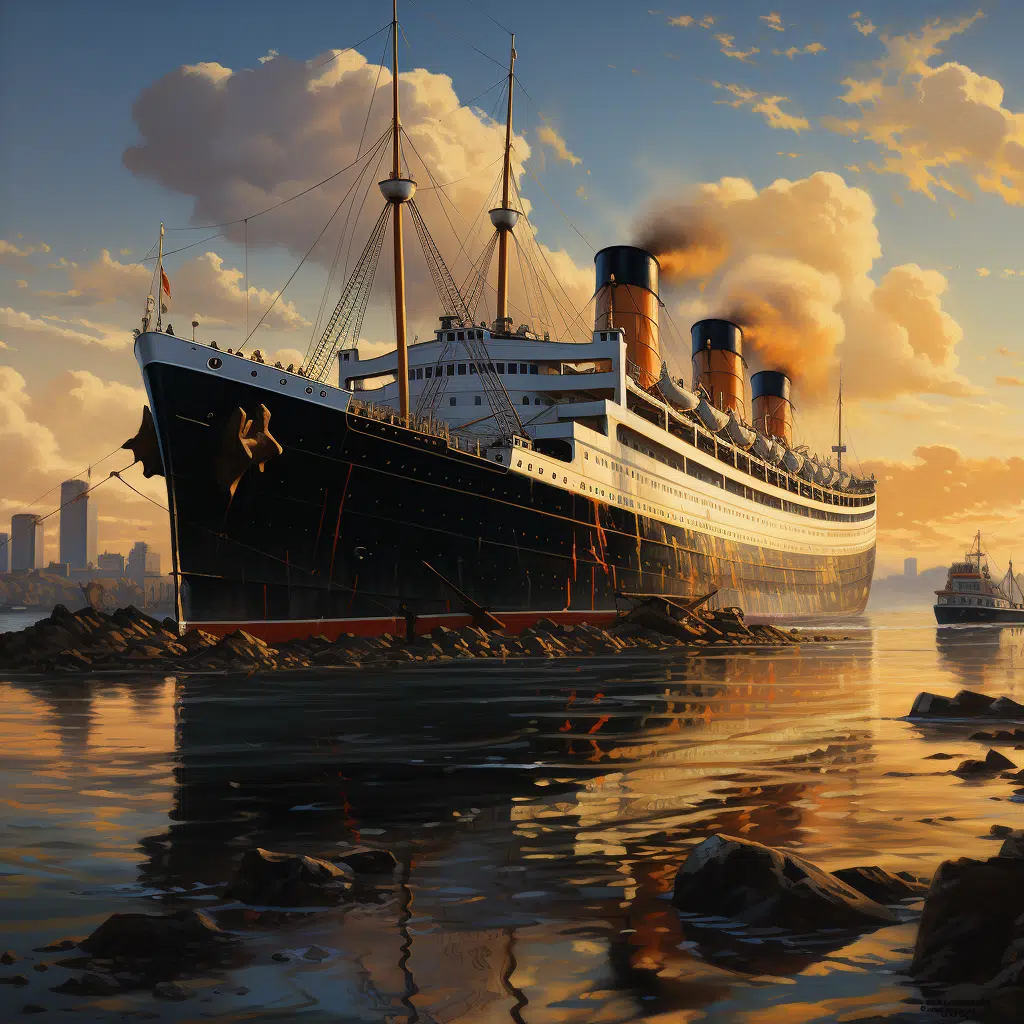
The Queen’s Coterie: RMS Queen Mary’s Dedicated Followers
From the highly knowledgeable maritime historian to the nostalgic enthusiast, the RMS Queen Mary attracts a mosaic of followers, each drawn to her for different reasons but connected by a profound admiration. These are the tireless guardians of her narrative, ensuring each gleaming rail and polished deck remains a testament to a bygone era’s elegance.
Their dedication transcends mere interest; it evolves into a culture—a community of the Queen Mary’s custodians. They are her storytellers, her advocates, and they play a vital role in both her preservation and the perpetuation of her legendary tale.
Conclusion: Sailing Into the Future with RMS Queen Mary’s Stories
As we draw the curtains on this journey through the RMS Queen Mary’s illustrious history, we’re reminded of the ship’s indelible mark on both maritime history and the cultural tapestry. Her story is not confined to the past; it’s a living narrative that continues to capture the imagination, a vessel for timeless tales of human tenacity and grandeur.
The Queen Mary sails on through the annals of time, piloted by the stories of those who know her best. Her legends remain an anchor in the shifting tides of memory, holding fast against the ebb and flow of progress. Here’s to the RMS Queen Mary, an icon of an era who still whispers to us of adventures on the grandest of scales.
RMS Queen Mary: A Voyage Through Time and Legend
Step right up, folks! Prepare to be dazzled by tales as legendary as the RMS Queen Mary herself—a veritable floating palace that has captured imaginations and hearts since she first set sail. This isn’t just any old yarn-spinning session; we’re diving into the depths of history to pluck out the quirkiest, most fascinating snippets of trivia about this luxurious ocean liner.
All Aboard the Fashion Express
Imagine strolling the decks of the RMS Queen Mary, ocean breeze tousling your hair, as you showcase the latest in seafaring fashion. Remember the times when those small Wallets For Women became all the rage? They say many a glamorous passenger flaunted such chic accessories aboard the Queen Mary, perfect for a posh evening at the ship’s high-society gatherings.
Hollywood at Sea
Get this: The RMS Queen Mary was such a beacon of luxury that it even caught the fancy of Tinseltown’s elite! It’s rumored that none other than screen siren Tippi Hedren , herself a fixture of Hollywood royalty, graced the vessel with her presence. Hedren, best known for her roles in Hitchcock’s thrillers, might’ve enjoyed the same stellar ocean views as we mere mortals daydream about!
Toasty Threads for Chilly Evenings
Oh, the chill of the open sea! You’d think the Atlantic’s icy grip could dampen the spirits of even the hardiest sailor. But fear not, for passengers aboard the grand dame were rumored to don fleece lined Jeans that kept them snug as a bug in a rug. These cozy duds weren’t just functional; they were a fashion statement with a side of practicality.
A Train Named Queen Mary
Now, don’t be thrown for a loop, but did you know there’s a hint of the RMS Queen Mary riding the rails? Word on the street is that the infamous 7 train in New York obtained the nickname ‘The International Express’ because of its diverse range of passengers, her spirit echoing the Queen Mary’s knack for bringing together folks from all walks of life. It’s the little connections like these that weave the fabric of history into a grand tapestry, isn’t it?
Camping with a Touch of the Queen Mary
And here’s a nugget for you outdoor enthusiasts: Imagine marrying the ruggedness of camping with the grandeur of the RMS Queen Mary. Impossible? Not quite! Reports say that the spaciousness and durability of those swanky Coleman Tents could rival the staterooms on the luxurious liner. Who knew that the wilds could hold a candle to the Queen Mary’s opulence?
Stepping Out in Maritime Style
Ever heard of the Queen Mary’s secret? Legend has it, her decks were often graced by the comfiest of maritime trends—none other than rubber Birkenstocks . Durable, waterproof, and, let’s face it, as quirky as they come, these foot-huggers might’ve been the go-to for passengers basking in the leisurely life at sea.
There you have it, folks—a chest full of the quirkiest, most whimsical tidbits about the RMS Queen Mary. Next time you swap stories with a fellow history buff, remember to sprinkle in these gems. With a past as rich as the Queen Mary’s, you never know what intriguing trivia might surface next!
RMS Queen Mary (Images of America)
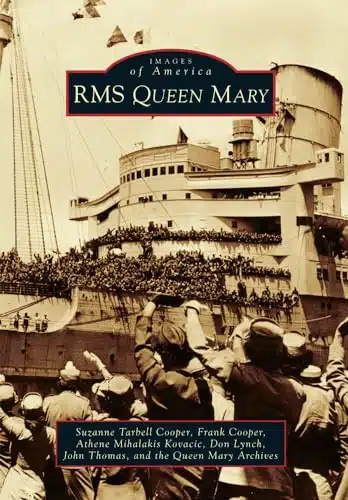
“RMS Queen Mary (Images of America)” is an enchanting pictorial voyage that charts the storied past of one of the most famous ocean liners in history. This enthralling book is brimming with vintage photographs and rare historical snapshots that capture the essence of the Queen Mary’s luxurious design, her notable passengers, and her service during World War II. Each page invites readers to step back in time and experience the grandeur and elegance that defined transatlantic travel in an era gone by.
Authors provide insightful commentary that accompanies the carefully curated images, allowing history buffs and maritime enthusiasts to delve deeper into the vessel’s rich narrative. From her launch in the tumultuous 1930s, through her wartime duties as the “Grey Ghost” transporting troops, to her final days as a beloved floating hotel and museum in Long Beach, California, this book is an exquisite tribute to the Queen Mary’s legacy. The collection showcases her Art Deco interiors, the splendor of her public rooms, and the technological marvels that made her the darling of the high seas.
“RMS Queen Mary (Images of America)” not only celebrates the majestic beauty of this ocean liner but also serves as an important document of maritime history. It is a must-have for anyone who cherishes nautical heritage or who appreciates the romance of travel in a time of steamships and star-studded voyages. Whether it’s reliving memories of a bygone era or discovering the Queen Mary’s allure for the first time , this book is an inviting treasury that encapsulates the spirit and adventure of one of the 20th century’s most iconic ships.
What happened to the RMS Queen Mary?
Well, the RMS Queen Mary has had quite the journey! After its illustrious career on the high seas, sailing from 1936 to 1967, she finally dropped anchor for good. The grand dame now sits pretty as a floating hotel and museum in Long Beach, California. But, hold your horses, time hasn’t been all too kind to her. Aging like any old celebrity, she’s been showing her wrinkles, needing some TLC to keep her from, you know, swimming with the fishes.
How many people died on the RMS Queen Mary?
Whoa, Nelly! Talking numbers, the RMS Queen Mary wasn’t exactly a cruise through paradise when it came to safety. While she was a World War II trooper, doubling as a troop ship, reports tally up to 239 fatalities aboard. Yikes! These were mostly due to wartime incidents, like the tragic accident when she sliced through her escort ship, the HMS Curacoa. Let’s just say it was a pretty grim chapter in her logbook.
Can you still go to the Queen Mary ship?
Sure can, buckaroos! The Queen Mary still welcomes landlubbers aboard. Though she’s taken off her seafaring hat, she’s donned a new one as a maritime attraction, hotel, and event space since 1971. Just trot on over to Long Beach, California, and you can gallivant through her historical decks, snooze in her cabins, or even spook yourself on a ghost tour—if you’re into that sort of thing.
Why did RMS Queen Elizabeth sink?
Oh, the RMS Queen Elizabeth met a fiery fate, and it wasn’t exactly a blaze of glory. Parked in Hong Kong’s waters in 1972, this ocean liner was taking a breather, refashioning herself into a floating university, when whoops—a fire broke out. Despite the hustle and bustle, efforts to save her were about as successful as a chocolate teapot. She went belly up, succumbing to the flames, and is now an underwater study in scuba diving and artificial reefs.
Is the Queen Mary bigger than Titanic?
In the duel of the ocean giants, the Queen Mary actually tips her hat to the Titanic in size—a little less brawnier, but just a hair. She’s roughly 1,000 gross tons lighter and a smidgen shorter, but hey, who’s counting when you’re that mammoth? The Queen Mary still made splashes with her plush accommodations and speed, showing that size isn’t everything, folks!
Why was Queen Mary called Bloody Mary?
Ah, “Bloody Mary,” a nickname that sends a shiver down your spine. Queen Mary I of England earned this charming moniker posthumously, thanks to her fondness for burning Protestants at the stake during her reign in the mid-1500s. She signed off on hundreds of these executions, trying to turn back the clock and restore Catholicism. As nicknames go, that one hit the nail on the head, grimly speaking.
Why is the Queen Mary ship famous?
Alright, gather ’round, history buffs! The Queen Mary ship made waves not only for her glamour but for her World War II service. Codenamed “Grey Ghost” for her stealthy, painted exterior, she was like a superhero of the seas, shuttling troops and POWs. Add her post-war luxury voyages to the mix, and you’ve got yourself a vessel that’s more storied than most novel characters.
How old was Queen Mary when she died?
Queen Mary lived a ripe old life, reigning and sprouting grey hairs until she was 85. She clocked out in 1953, just a tad before rock ‘n’ roll took the stage, witnessing the world change from horse-drawn to horsepower.
Which Queen Mary died of smallpox?
Mary of Teck’s the one who kissed the world goodbye, but not from smallpox, mind you. It was her namesake, Mary II of England, who succumbed to the pox in 1694. Yep, that pesky virus didn’t play favorites, even with royalty.
How is Queen Elizabeth related to Queen Mary?
Here’s the royal connection: Queen Elizabeth II was Queen Mary’s granddaughter. See, Queen Mary was married to George V, right? Their son, George VI, was Liz’s dear old dad. So, it’s a classic family tree situation—no need to bring Maury in to sort this one out!
Will the Queen Mary ever reopen?
Will she or won’t she? The Queen Mary might reopen, fingers crossed, and the latest scuttlebutt is promising. Repairs are underway to give her a spruce-up, so hopefully, she’ll swing her doors open again. But, the date’s as vague as a weather forecast in spring—could be sooner, could be later.
Why did they stop using the Queen Mary ship?
Well, why’d they stop using the ol’ Queen Mary? Because the jet age swooped in, and, “Poof!”—there went the demand for transatlantic ship travel. By 1967, planes were the new hot ticket for crossing the pond, and our lady of the sea just couldn’t keep up. So, she elegantly exited stage left, lighting up Long Beach with her permanent residency.
What is the world’s largest shipwreck?
The world’s most gigundo shipwreck is the Titanic’s less talked about, but way bigger, cousin—the MV Wilhelm Gustloff. This German liner was packed to the gills with refugees during World War II when a Soviet submarine sent her to Davy Jones’ Locker with a torpedo handshake. We’re talking tragic, folks; over 9,000 souls lost at sea, making it a shipwreck of epic, heartbreaking proportions.
What ship sank Queen Elizabeth 1?
Haha, hold your horses! No ship sank good ol’ Queen Liz I—she was the mighty monarch of England from 1558 to 1603. Keelhauling wasn’t on her agenda, and the only sinking she did was into the annals of history as one of the greatest queens. Gotcha with a bit of historical jesting, didn’t I?
What replaced the QE2?
When the QE2 said her bon voyage to the high seas in 2008, along came the grand dame, the RMS Queen Mary 2, strutting her stuff. She’s the leggy heiress to the throne of transatlantic luxury travel, a true ocean queen if there ever was one. Decked out with all the modern glitz and glam, QM2 keeps the Cunard lineage sailing smooth.
- January 14, 2024
- No Comments
Leave a Reply Cancel reply
You must be logged in to post a comment.
Don’t Miss Out…
Get Our Weekly Newsletter!

Get the Latest With Our Newsletter
Cruising The Past Cruise News
Coulter’s steamlined modern department store miracle mile los angeles.

RMS Queen Mary – The Maiden Voyage in 1936 – President John Kennedy
Posted by: Michael Grace January 10, 2017
The floating palace for the rich and famous: Vintage photos reveal glamor on board the Queen Mary during her maiden voyage.
First Class Dining Room
- RMS Queen Mary left Southampton on M en route to New York, the first of many transatlantic crossings.
Elizabeth Taylor walking her dogs.
- She hosted the wealthy and elite, including Winston Churchill, John F Kennedy, Elizabeth Taylor and Bob Hope
Today, the historic ship is permanently moored as a tourist attraction with a museum, hotel, cafes, and restaurants.
Joseph Kennedy and his son (future President) John F. Kennedy on board RMS Queen Mary.
- The RMS Queen Mary, a luxurious ocean liner that carried the world’s rich and famous before the dawn of the jet age, is celebrating the 80th anniversary of its maiden voyage.
English actress and singer Gertrude Lawrence (nearest to camera) and her dining companions on board the RMS Queen Mary in 1939
- One of the greatest passenger ships ever built, the 1,020ft Queen Mary left Southampton on May 27, 1936, en route to New York, the first of many transatlantic crossings that attracted the likes of Winston Churchill, John F Kennedy, TS Eliot, Elizabeth Taylor, Bob Hope and many other glamorous guests.
Passengers have boarded the Cunard-White Star Line ship Queen Mary at Southampton as she is ready to set sail on her maiden voyage to New York
- The Art Deco liner was the largest and fastest passenger ship in the world when it launched. The liner had three classes of cabins, an opulent first class dining room, ballroom, cocktail bars, a stage for music, two indoor swimming pools, a squash court, libraries, a telephone connection and a small hospital. It was the flagship of Liverpool-based Cunard-White Star Line when it left John Brown & Company’s shipyard in Clydebank, Scotland after six years of construction.
First Class passengers had a number of elegant dining options, including the veranda grill where they were entertained by a pianist
The historic Queen Mary transported Allied soldiers during World War Two and returned to passenger service until it was retired in 1967 as profits dropped and the jet age took off.
Today, the historic ship is permanently moored in Long Beach, California, where it has been preserved as a tourist attraction with a museum, hotel, restaurants and an exhibition containing some of Princess Diana’s belongings.
Popular Articles

April 3, 2024

THE LARK – All-Pullman Sleeper Train – Overnight – San Francisco to Los Angeles
April 1, 2024

California’s Old Movie Palaces New Video
March 12, 2024

Berlin’s Famous Hotel Adlon Five Stars
March 1, 2024

Judy Garland Premiere of A Star Is Born
February 14, 2024

RMS Titanic – Books Passengers Were Reading On The Doomed Voyage
© 2022-2023 The Past and Now. All Rights Reserved.
Any copying or reproduction of images or media herein is strictly prohibited.
- CONTACT MICHAEL GRACE
- Refine your search results by reviewing SEARCH TIPS
- Site tech support provided by Ted Angel

Soviet to Rebuild Moscow In 10 Years
Harold denny, modern city thrice as big as the present one to house 5,000,000 is planned. special cable to the new york times..
Ambitious to make Moscow the greatest city in the world, competing with Hitler’s plan to reshape Berlin, Stalin decreed in 1935 that a New Moscow would rise. Frustrated by the tangle and sprawl of the city he inherited, his plan was based not on individual buildings, but on larger blocks and districts, taller buildings to accommodate a denser population, and plenty of green park space to maintain citizens’ health. The New York Times reported on the ambition of the plan. Though not entirely realized, many of Moscow’s finest features to this day were laid out in that plan.
Original Source: New York Times, 11 July 1935, p. 1.
KREMLIN IS TO REMAIN Red Square Will Be Enlarged Parks, Boulevards and Airy Apartments Proposed.
MOSCOW, July 10. — An all-inclusive plan for rebuilding Moscow in ten years into a completely modern metropolis, covering more than three times the area of the present city and providing comfortably and spaciously for a 5,000,000 population, was adopted today jointly by the Council of People’s Commissars and the central committee of the Communist party.
A decree embodying the plan and ordering the State. Planning Commission-which prepares the five-year plans to work out complete details, together with costs, was signed tonight by Joseph Stalin, Soviet dictator, and Viacheslav Molotov, Soviet Premier.
By its provisions most of what remains of the old Moscow of narrow, winding streets and bulbous Byzantine towers one of the most picturesque cities in the world, even · if dirty and uncomfortable is to disappear. In its place is to rise a 1 new city of large squares, parks, wide boulevards, an entirely reorganized and many times enlarged ·transportation system and large apartment buildings with space between them to furnish light and air. In the words of tonight’s decree. “the construction and architectural design of the capital of the U.S.S.R. must perfectly reflect the grandeur and the beauty of the Socialist epoch.”
Rejected Plan for New Site
In adopting the plan announced tonight the Soviet rulers have rejected projects seriously advanced; for abandoning the present Moscow altogether and retaining this ancient capital of the Czars as a dead city — a lifeless museum of the past — and creating a new city beyond the boundaries of the present one.
They also rejected a proposal to destroy the present city and build an entirely new one on its site. They decided instead to preserve the bases of the city as laid out by history, but radically to reform them.
There is nothing in the decree to indicate that the Kremlin — probably the most fascinating conglomeration of buildings in the world and an area in which unbelievable events have occurred for centuries — is to go. Nor St. Basil’s Cathedral. It is reported from sources close to the Soviet leaders that Mr. Stalin appreciates the strange beauty of the Kremlin and would not countenance such an act of vandalism.
But the plans provide for the demolition of the old Trading Rows directly opposite Lenin’s tomb to make Red Square, already a huge space, twice its present size. Smaller buildings in Kitai-Gorod, the “Chinese city,” an old labarynthine section which once was Moscow’s business centre, are to be demolished and in their places will rise monumental structures to house the government departments which now are scattered all over Moscow.
Much of this vast reconstruction project — which is the most ambitious piece of municipal planning ever adopted anywhere — must take place in the next three years and the whole plan is to be fitted into the structure of the general five-year plan of the Soviet Union under which the entire Soviet economy is being rebuilt.
First Spread to Southwest
The first expansion of Moscow, which under the plan will grow from seventy square miles to more than 230, will be to the southwest beyond Lenin Hills, the old Sparrow Hills, from which Napoleon had his first view of Moscow. Eleven new bridges are to be built over Moscow River. The next city will grow eastward.
Tonight’s decree calls for the removal of street cars from congested districts, the laying out of other street-car lines, and thousands of buses and taxicabs. All streets and squares are to be paved with asphalt. The gas, water and electric systems must be greatly enlarged and improved. Hundreds of new schools, nurseries and clinics will be constructed. New motion-picture theatres, clubs, department stores, refrigerating plants and even a big vegetable warehouse underground are included in the plan.
Comments are closed.
- Abolition of Legal Abortion
- Childhood under Stalin
- Creation of the Ethnic Republics
- The Great Terror
- Pilots and Explorers
- Popular Front
- Rebuilding of Moscow
- Rehabilitation of Cossack Divisions
- Second Kolkhoz Charter
- Stalin Constitution
- Upheaval in the Opera
- Year of the Stakhanovite
Ch. 9 The Development of Russia
Ivan i and the rise of moscow, learning objective.
- Outline the key points that helped Moscow become so powerful and how Ivan I accomplished these major victories
- Moscow was considered a small trading outpost under the principality of Vladimir-Suzdal into the 13th century.
- Power struggles and constant raids under the Mongol Empire’s Golden Horde caused once powerful cities, such as Kiev, to struggle financially and culturally.
- Ivan I utilized the relative calm and safety of the northern city of Moscow to entice a larger population and wealth to move there.
- Alliances between Golden Horde leaders and Ivan I saved Moscow from many of the raids and destruction of other centers, like Tver.
A rival city to Moscow that eventually lost favor under the Golden Horde.
Grand Prince of Vladimir
The title given to the ruler of this northern province, where Moscow was situated.
The Rise of Moscow
Moscow was only a small trading outpost in the principality of Vladimir-Suzdal in Kievan Rus’ before the invasion of Mongol forces during the 13th century. However, due to the unstable environment of the Golden Horde, and the deft leadership of Ivan I at a critical time during the 13th century, Moscow became a safe haven of prosperity during his reign. It also became the new seat of power of the Russian Orthodox Church.
Ivan I (also known as Ivan Kalita) was born around 1288 to the Prince of Moscow, Daniil Aleksandrovich. He was born during a time of devastation and upheaval in Rus’. Kiev had been overtaken by the invading Mongol forces in 1240, and most of the Rus’ principalities had been absorbed into the Golden Horde of the Mongol Empire by the time Ivan was born. He ascended to the seat of Prince of Moscow after the death of his father, and then the death of his older brother Yury.

Ivan I. He was born around 1288 and died in either 1340 or 1341, still holding the title of Grand Prince of Vladimir.
Ivan I stepped into a role that had already been expanded by his predecessors. Both his older brother and his father had captured nearby lands, including Kolomna and Mozhaisk. Yury had also made a successful alliance with the Mongol leader Uzbeg Khan and married his sister, securing more power and advantages within the hierarchy of the Golden Horde.
Ivan I continued the family tradition and petitioned the leaders of the Golden Horde to gain the seat of Grand Prince of Vladimir. His other three rivals, all princes of Tver, had previously been granted the title in prior years. However they were all subsequently deprived of the title and all three aspiring princes also eventually ended up murdered. Ivan I, on the other hand, garnered the title from Khan Muhammad Ozbeg in 1328. This new title, which he kept until his death around 1340, meant he could collect taxes from the Russian lands as a ruling prince and position his tiny city as a major player in the Vladimir region.
Moscow’s Rise
During this time of upheaval, the tiny outpost of Moscow had multiple advantages that repositioned this town and set it up for future prosperity under Ivan I. Three major contributing factors helped Ivan I relocate power to this area:
- It was situated in between other major principalities on the east and west so it was often protected from the more devastating invasions.
- This relative safety, compared to Tver and Ryazan, for example, started to bring in tax-paying citizens who wanted a safe place to build a home and earn a livelihood.
- Finally, Moscow was set up perfectly along the trade route from Novgorod to the Volga River, giving it an economic advantage from the start.
Ivan I also spurred on the growth of Moscow by actively recruiting people to move to the region. In addition, he bought the freedom of people who had been captured by the extensive Mongol raids. These recruits further bolstered the population of Moscow. Finally, he focused his attention on establishing peace and routing out thieves and raiding parties in the region, making for a safe and calm metaphorical island in a storm of unsettled political and military upsets.

Kievan Rus’ 1220-1240. This map illustrates the power dynamics at play during the 13th century shortly before Ivan I was born. Sarai, the capital of the Golden Horde, sat to the southeast, while Moscow (not visible on this map) was tucked up in the northern forests of Vladimir-Suzdal.
Ivan I knew that the peace of his region depended upon keeping up an alliance with the Golden Horde, which he did faithfully. Moscow’s increased wealth during this era also allowed him to loan money to neighboring principalities. These regions then became indebted to Moscow, bolstering its political and financial position.
In addition, a few neighboring cities and villages were subsumed into Moscow during the 1320s and 1330s, including Uglich, Belozero, and Galich. These shifts slowly transformed the tiny trading outpost into a bustling city center in the northern forests of what was once Kievan Rus’.
Russian Orthodox Church and The Center of Moscow
Ivan I committed some of Moscow’s new wealth to building a splendid city center and creating an iconic religious setting. He built stone churches in the center of Moscow with his newly gained wealth. Ivan I also tempted one of the most important religious leaders in Rus’, the Orthodox Metropolitan Peter, to the city of Moscow. Before the rule of the Golden Horde the original Russian Orthodox Church was based in Kiev. After years of devastation, Metropolitan Peter transferred the seat of power to Moscow where a new Renaissance of culture was blossoming. This perfectly timed transformation of Moscow coincided with the decades of devastation in Kiev, effectively transferring power to the north once again.

Peter of Moscow and scenes from his life as depicted in a 15th-century icon. This religious leader helped bring cultural power to Moscow by moving the seat of the Russian Orthodox Church there during Ivan I’s reign.
One of the most lasting accomplishments of Ivan I was to petition the Khan based in Sarai to designate his son, who would become Simeon the Proud, as the heir to the title of Grand Prince of Vladimir. This agreement a line of succession that meant the ruling head of Moscow would almost always hold power over the principality of Vladimir, ensuring Moscow held a powerful position for decades to come.
- Boundless World History. Authored by : Boundless. Located at : https://www.boundless.com/world-history/textbooks/boundless-world-history-textbook/ . License : CC BY-SA: Attribution-ShareAlike

IMAGES
VIDEO
COMMENTS
Richard Cavendish describes the maiden voyage of the Queen Mary on May 27th, 1936. Richard Cavendish | Published in History Today Volume 61 Issue 5 May 2011. The Queen Mary arrives in New York Harbor, June 20, 1945. US National Archives. According to legend while the Cunard-White Star Line's new Hull Number 534 was under construction at the ...
Queen Mary sailed on her maiden voyage on 27 May 1936 and won the Blue Riband that August; she lost the title to SS Normandie in 1937 and recaptured it in 1938, holding it until 1952, when it was taken by the new SS United States. With the outbreak of World War II, she was converted into a troopship and ferried Allied soldiers during the ...
The Queen Mary was in service from 1936 to 1967, and it later became a hotel and tourist attraction, docked at Long Beach, California. In the late 1920s the Cunard Line faced an aging fleet ... On May 27, 1936, the Queen Mary embarked on its maiden voyage, traveling from Southampton, England, to New York City, with a stop in Cherbourg, France ...
The Maiden Voyage Of The Queen Mary. On May 27, 1936, the Queen Mary departed from Southampton, England embarking on her maiden voyage. She boasted five dining areas and lounges, two cocktail bars and swimming pools, a grand ballroom, a squash court and even a small hospital. The Queen Mary had set a new benchmark in transatlantic travel, which ...
The Maiden Voyage - 27 May, 1936. After completion, and brief trials to establish that her engines and other systems were functioning correctly, the Queen Mary arrived in Southampton for the start of her maiden voyage to New York. Between May 21 and May 23, 15,000 people paid five shillings each to be shown around the new ship.
The ship went into service in 1936, and in August of that year it captured the fabled "Blue Ribband" prize for the fastest transatlantic passage. ... The RMS Queen Mary's Maiden Voyage as a Troopship. On May 4, 1940, Queen Mary left Sydney with 5,000 Aussie troops aboard. The great liner joined other "drafted" passenger ships ...
Picture it: May 27th, 1936—RMS Queen Mary sets off on her maiden voyage. The air buzzes with anticipation, the champagne sparkles, and the golden age of transatlantic travel adds another star to its glittering firmament. As she steamed out of Southampton, every inch of this magnificent ocean liner announced a new era of luxury travel.
Joseph Kennedy and his son (future President) John F. Kennedy on board RMS Queen Mary. The RMS Queen Mary, a luxurious ocean liner that carried the world's rich and famous before the dawn of the jet age, is celebrating the 80th anniversary of its maiden voyage. English actress and singer Gertrude Lawrence (nearest to camera) and her dining ...
Leaving Southampton on 27 May 1936, her maiden voyage to New York set a new benchmark in transatlantic travel. ... The Queen Mary was a great attraction to the rich and famous celebrities of the ...
28 January 2022. Google. Queen Mary is a closed tourist attraction in Long Beach, California. A woman who was on the maiden voyage of legendary cruise liner Queen Mary has recalled the trip as she ...
On May 27th, 1936 the RMS Queen Mary set sail on her maiden voyage across the Atlantic Ocean. This would be the first of over 1,000 trips for the British Oce...
On May 27, 1936, the Cunard liner RMS Queen Mary left England on its maiden voyage to New York. Greatest Liner has auspicious start on her career.You can lic...
The Queen Mary sailed on her Maiden Voyage in 1936 from Southampton, England to New York City. In 31 years of plying the North Atlantic Ocean in war and peace, in fair weather and foul, the Queen Mary would become the most legendary ocean liner the world has ever known. Winston Churchill enjoyed travelling in grand style by sea and crossed the ...
GAUMONT BRITISH NEWSREEL (REUTERS)To license this film, visit https://www.britishpathe.com/video/VLVA195FBBLPAR93FO6C1C0FV1YLJ-THE-QUEEN-MARY-ARRIVES-IN-NEW-...
Built in the final era before passenger airlines became popular and when ships still dominated trans-Atlantic travel, RMS Queen Mary was designed with all the best features of the ocean liners that had come before it. When it departed from England on May 27, 1936, on its maiden voyage across the Atlantic Ocean, the ship had a ballroom, two swimming pools, a library, a musical stage, and a ...
RMS Queen Mary Passenger Lists 1936-1960. The RMS Queen Mary of the Cunard Line. GGA Image ID # 13edc635ec. Queen Mary (1936) Cunard Line ... Listing Includes Date Voyage Began, Steamship Line, Vessel, Passenger Class and Route. View our RMS Queen Mary Archival Collection for Ephemera including Passenger Lists, Menus, Brochures, Event Programs ...
1936 - 1939. 1929. April 3 ... RMS Foundation, Inc., schedules Diamond Jubilee Celebration for the 60th Anniversary of the Queen Mary's Maiden Voyage from Southampton to New York. 1997. May 31 "Titanic: The Expedition" exhibit makes its West Coast debut aboard the Queen Mary. December 9.
The Queen Mary crossed the Atlantic Ocean in a record time of 3 days, 23 hours and 57 minutes to claim the Blue Riband. The head of Thomas Jefferson on the Mount Rushmore sculpture was dedicated in a ceremony attended by President Roosevelt. Died: Carlos José Solórzano, 76, President of Nicaragua 1925-26; August 31, 1936 (Monday)
1. Parks, Boulevards and Airy Apartments Proposed. MOSCOW, July 10. — An all-inclusive plan for rebuilding Moscow in ten years into a completely modern metropolis, covering more than three times the area of the present city and providing comfortably and spaciously for a 5,000,000 population, was adopted today jointly by the Council of People ...
Ivan I (also known as Ivan Kalita) was born around 1288 to the Prince of Moscow, Daniil Aleksandrovich. He was born during a time of devastation and upheaval in Rus'. Kiev had been overtaken by the invading Mongol forces in 1240, and most of the Rus' principalities had been absorbed into the Golden Horde of the Mongol Empire by the time ...
The classically inspired Menin Gate in Ypres. World War I is remembered and commemorated by various war memorials, including civic memorials, larger national monuments, war cemeteries, private memorials and a range of utilitarian designs such as halls and parks, dedicated to remembering those involved in the conflict.Huge numbers of memorials were built in the 1920s and 1930s, with around ...